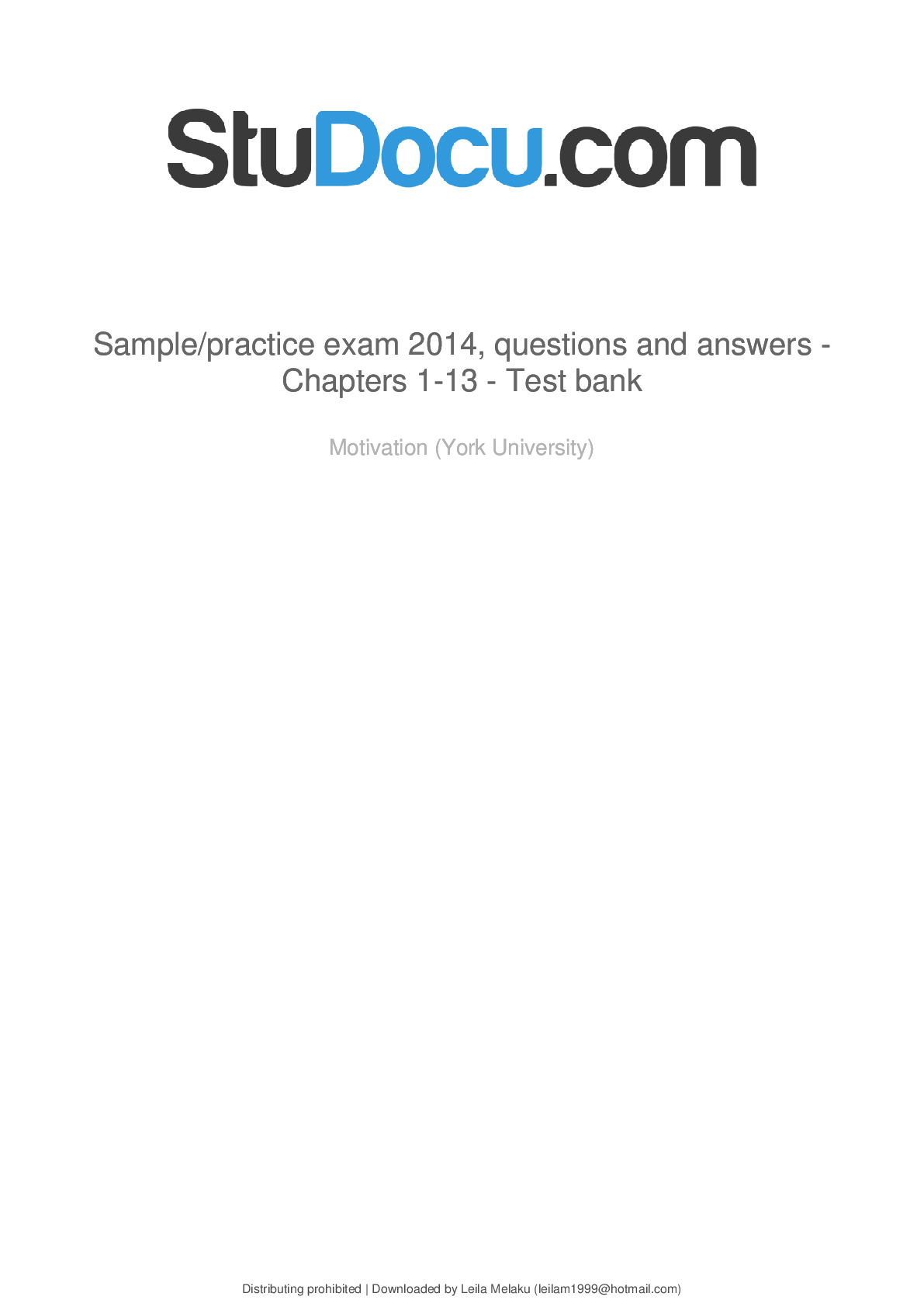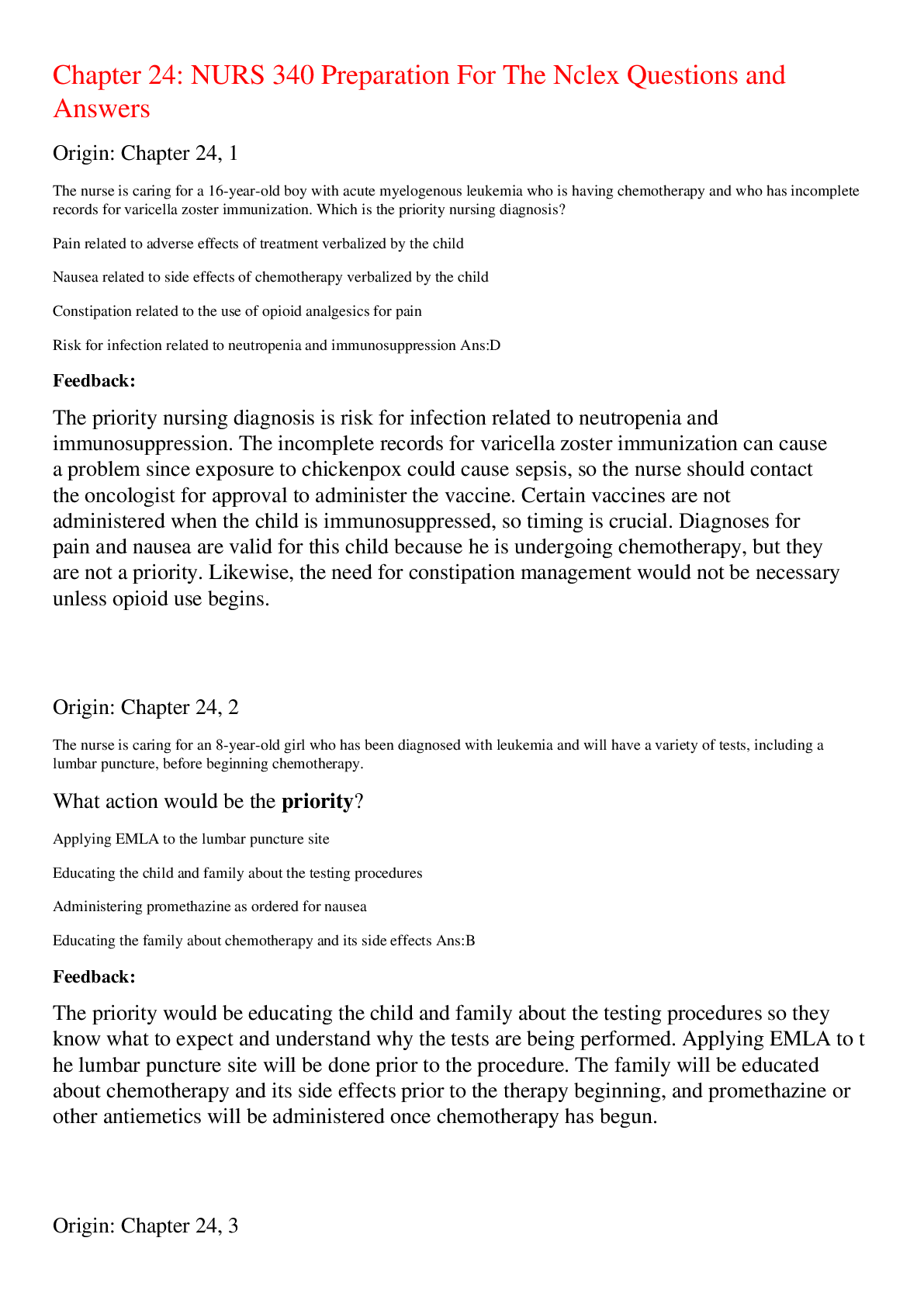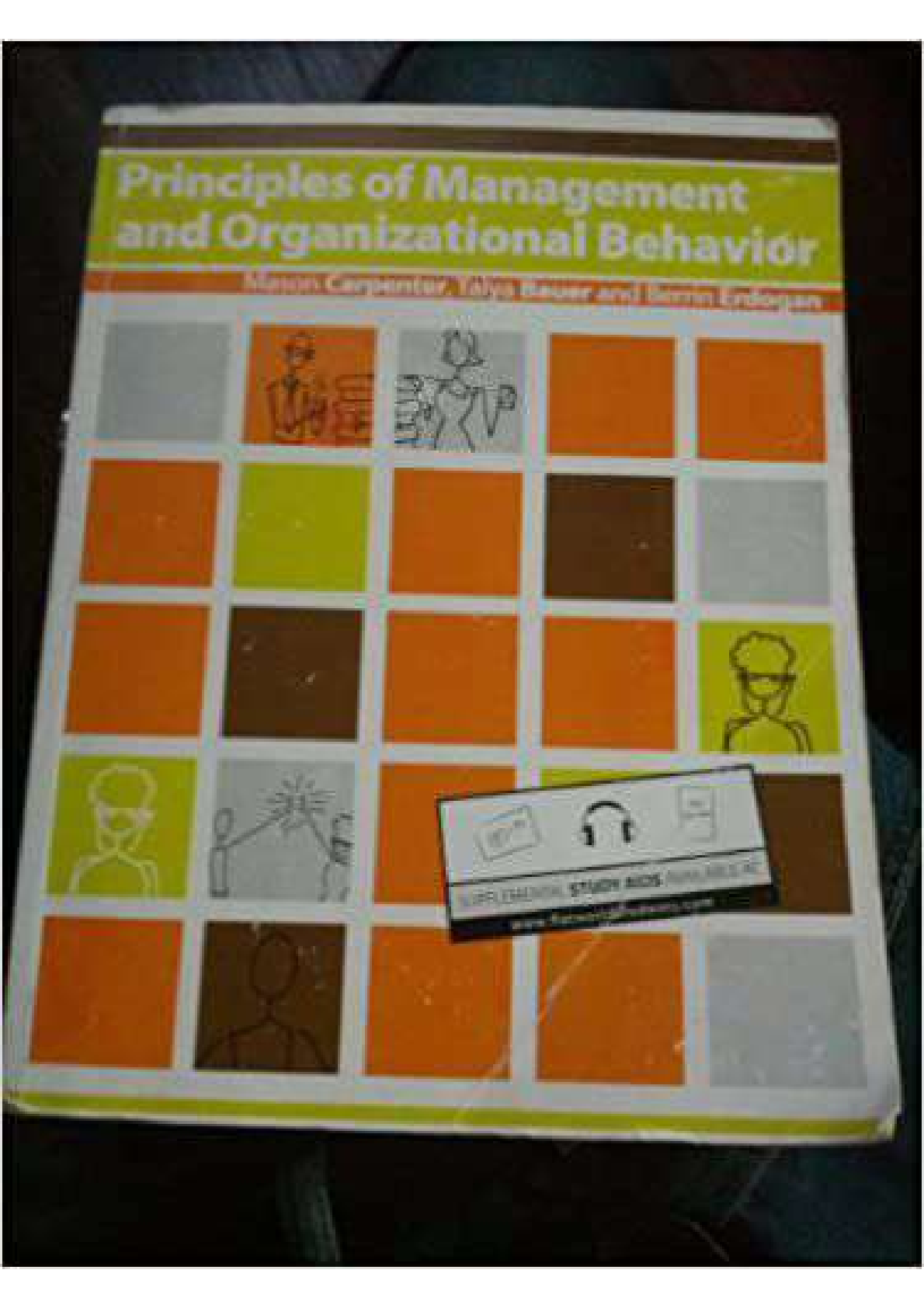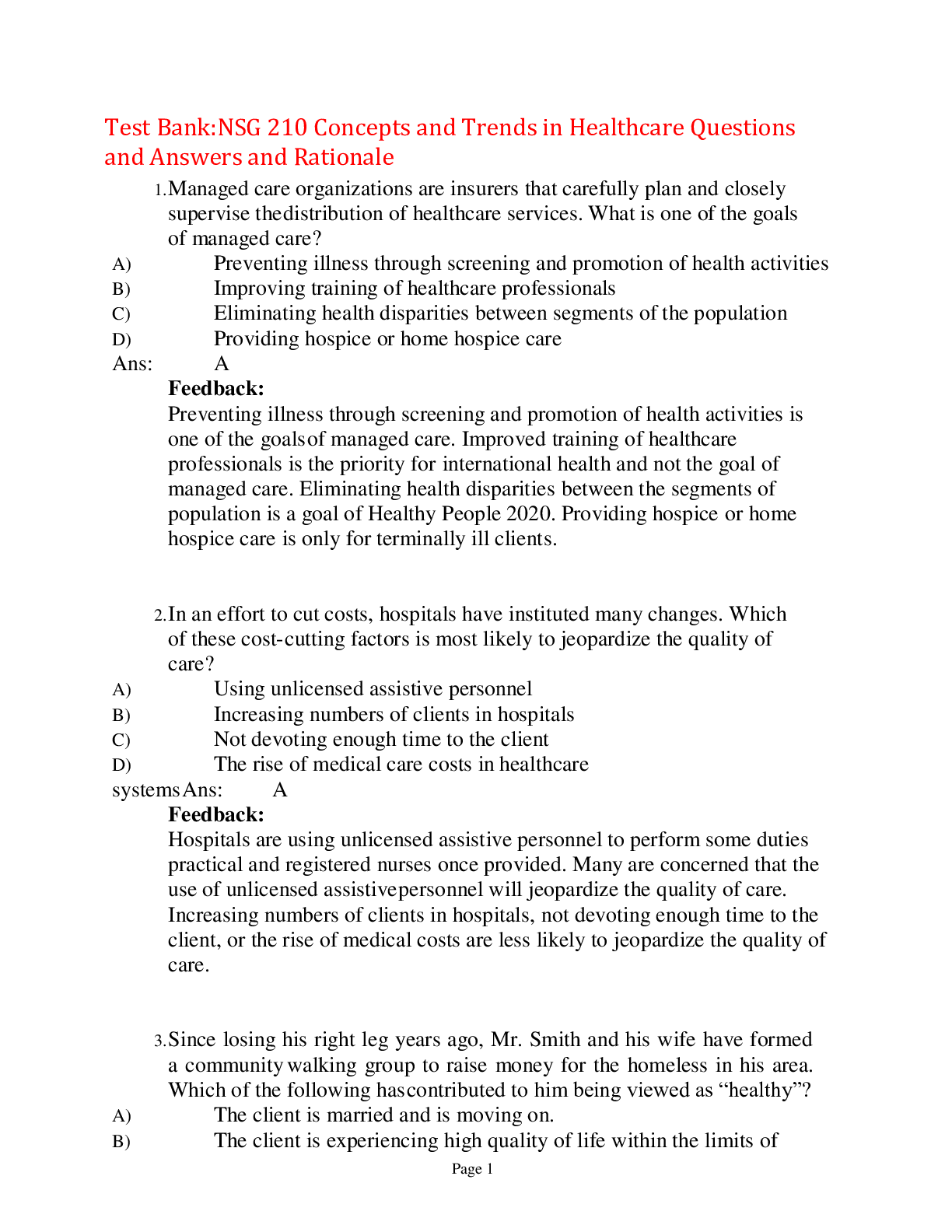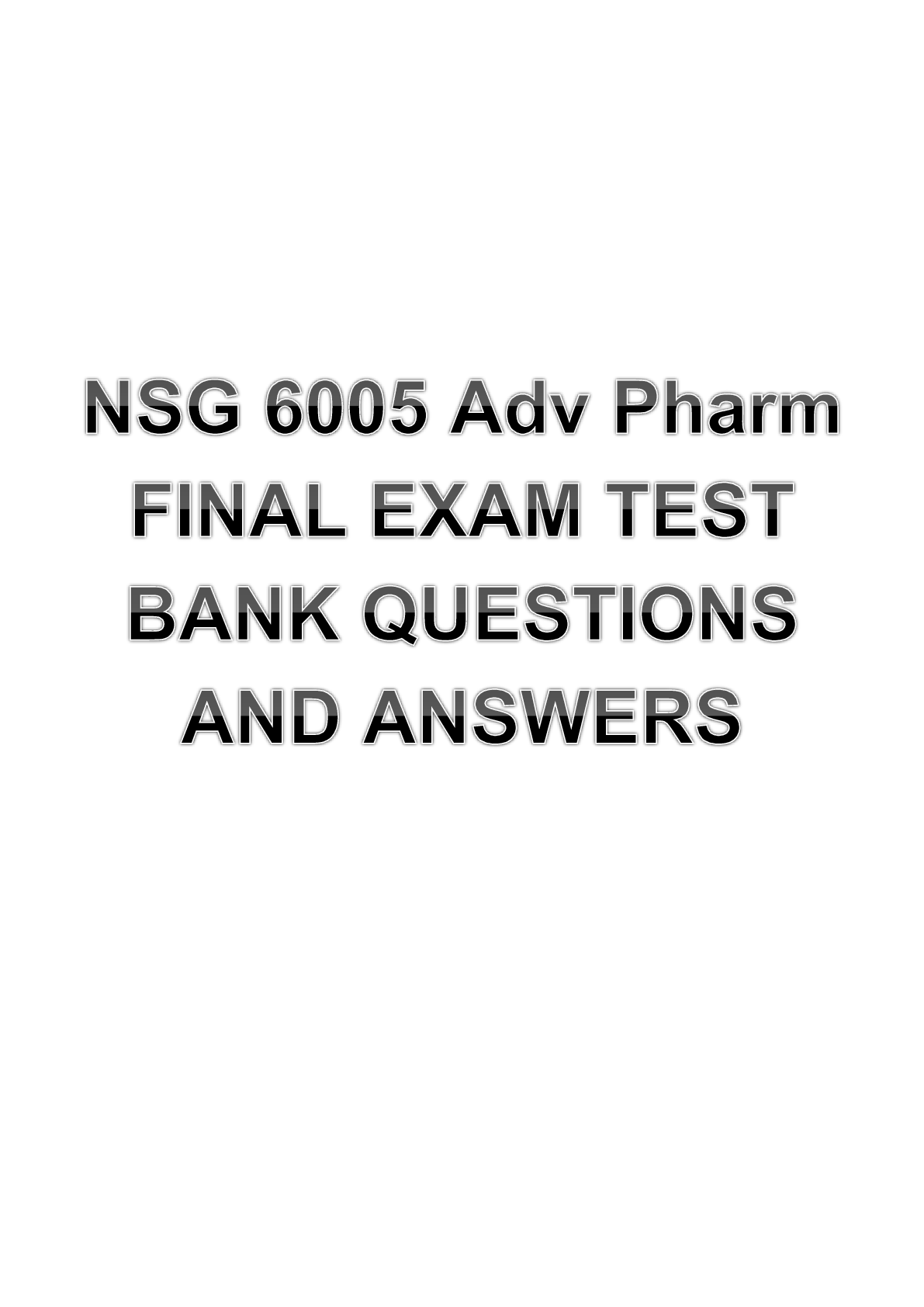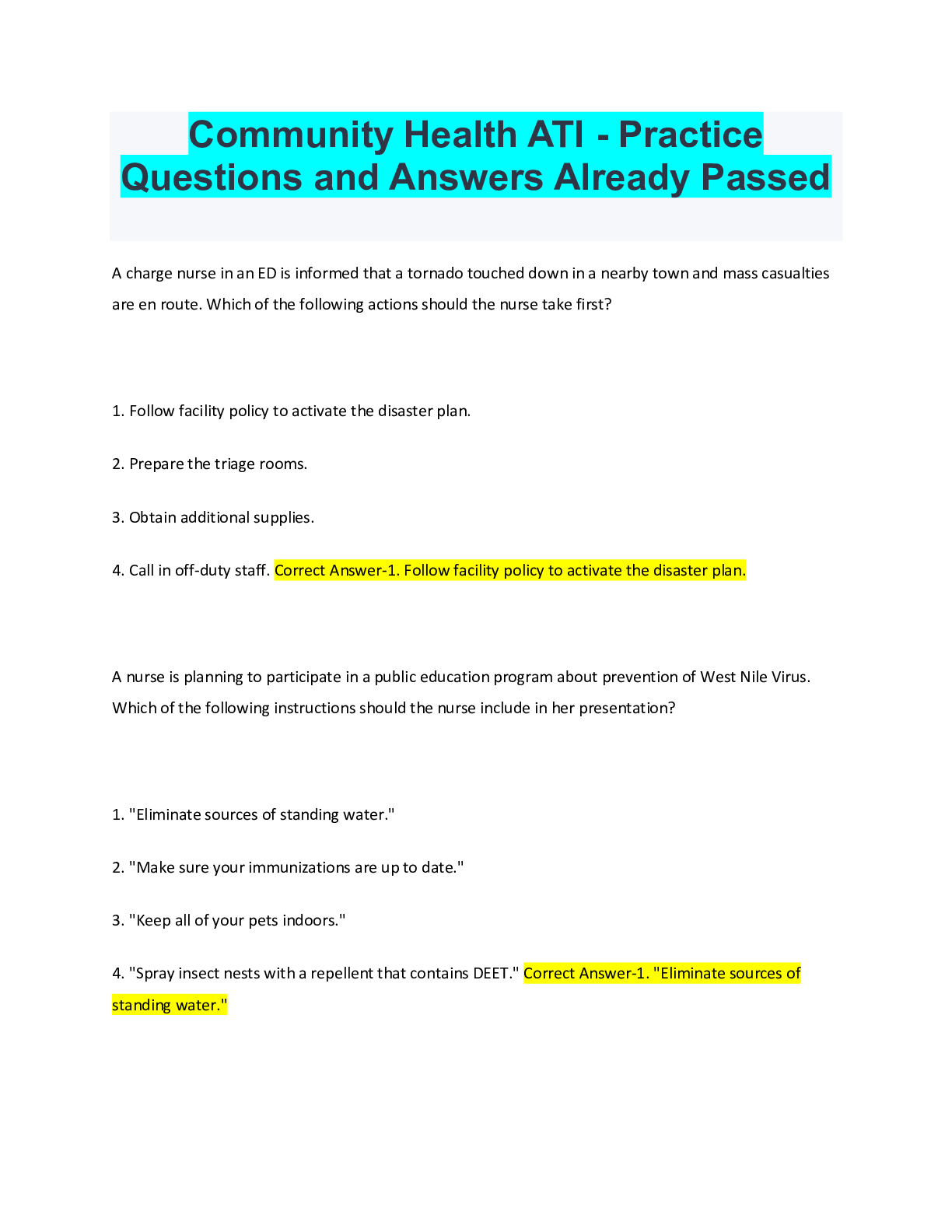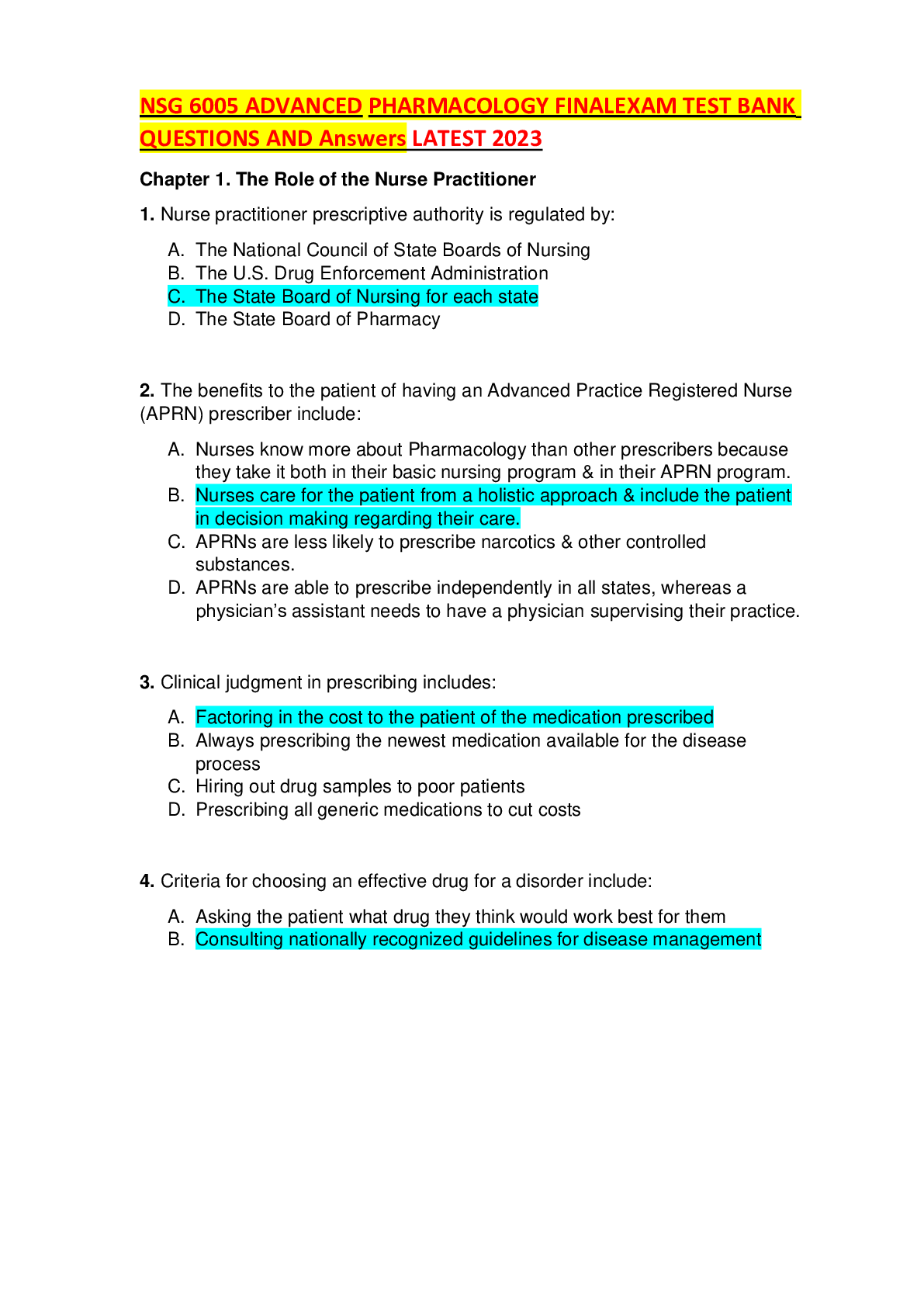RN Concept-Based Assessment Level 1 Questions And Answers Inclusive
Document Content and Description Below
RN Concept-Based Assessment Level 1 ATest Bank, Latest • A nurse is admitting a client who has pulmonary tuberculosis. Which of the followingtransmission-based precautions should the nurse initiat e... ? • Airborne • Rationale: Pulmonary tuberculosisis an infection that is transmitted by airbornedroplets smaller than 5 microns in diameter. Therefore, this client requires airborne precautions to prevent communicating this infection to others • A nurse in a mental health facility is preparing an educational program for a group ofstaff nurses about the proper use of restraints. Which of the following information should the nurse plan to include? • An adult client may be in a mechanical restraint for up to 4 hours • Rational: The nurse should specify that a client who is 18 years or older may be in a restraint for no more than 4 hr. Children who are 9 to 17 years old are limited to 2 hr and children who are younger than 9 years old are limited to 1 hr • A nurse is teaching sleep hygiene to a client who has insomnia. Which of the followingstatements should the nurse make? • Exercise in the morning after arising • Rationale: Daily exercise has many benefits, including enhancing cardiovascular,psychological, and musculoskeletal health. The nurse should recommend that the client avoid exercising within 2 hr of bedtime to limit stimulation and enhance sleep • A nurse is preparing to leave the room of a client who is on isolation precautions. Whichof the following actions should the nurse take when removing a tied surgical mask? • Remove the mask by securely holding the ties and moving it away from the face • Rationale: The nurse should untie the bottom strings and then the top strings.Finally, while still holding the strings, the nurse should remove the mask fromher face. This action prevents the nurse from touching the front of the mask, which is contaminated • A nurse is caring for an adolescent client who is in critical condition following a motor vehicle crash in which he was the passenger. The client's parent shouts at the nurse, asking why her son is dying instead of the driver. Which of the following actions shouldthe nurse take to provide emotional support to the parent? • Inform the parent that anger is a natural response when dealing with loss • Rationale: The nurse should identify that the parent is in the anger stage of grief.The nurse should assist the parent to understand that anger is a natural response to loss and encourage her to talk about her feelings • A community health nurse is planning prevention strategies for hypertension amongmembers of her community. The nurse should identify that which of the following ethnic groups in the community is at greatest risk of developing hypertension? • African Americans • Rationale: Evidence-based practice indicates that individuals of African-Americanethnicity have the highest prevalence of hypertension. Therefore, the nurse should identify community members of this ethnicity are at greatest risk of developing hypertension. • A community health nurse is planning interventions to promote Healthy People 2020 initiatives in the community. Which of the following actions should the nurse plan totake first? • Determine the level of health equity among groups in the community • Rationale: Health equity among all groups in the community is a Healthy People 2020 initiative. Using the nursing process, the first action the nurse should take isto assess the needs of the community. By identifying disparities in community health, the nurse can develop interventions targeted at the community's specificneeds. • A nurse is reviewing a client's new prescriptions that were just documented in the client's medical record by the provider. Which of the following abbreviations should thenurse clarify with the provider? • Enoxaparin 40 mg SQ QD • Rationale: The nurse should clarify this prescription with the provider. The abbreviations "SQ" and "QD" are considered errorprone and should not be usedin documentation. The nurse should clarify that the provider intends the prescription to be administered subcutaneously once daily. "Subcutaneous" or "subcut" should be used instead of "SQ" and "daily" should be used instead of "QD." • A nurse is talking with a client who has major depressive disorder. The client states, "Nobody cares if I'm around or not." Which of the following responses should the nursetake? • It sounds as though you’re feeling hopeless • Rationale: This statement by the nurse is an example of restating, which is atherapeutic response. This technique restates the main idea the client has expressed and allows the client to clarify any misunderstanding. • A nurse is preparing to administer a unit of packed RBCs to a client. In adherence withthe Joint Commission National Patient Safety Goals regarding blood administration, which of the following actions should the nurse plan to take? • Rationale: The Joint Commission National Patient Safety Goalsregarding bloodtransfusions includes improving the accuracy of client identification. The nurse • Verify the client and blood component using a two-person process • should eliminate transfusion errors related to client misidentification by using atwo-person verification process to identify the client and the blood component. • A nurse on a medical-surgical unit is caring for a group of clients. Which of the followingclients should the nurse monitor for the development of reflex urinary incontinence? • A client who has a T12 spinal cord injury • Rationale: The nurse should identify that a client who has a C1 to S2 spinal cordinjury is at risk of developing reflex urinary incontinence. With this type of incontinence, the client is unaware that the bladder is full and therefore lacks the urge to void, resulting in the involuntary loss of urine. The nurse should monitor for this form of incontinence and implement interventions such as intermittent catheterization. • A nurse is documenting an assessment in a client's electronic health record when an assistive personnel (AP) asks to enter the morning blood glucose for the client. Which ofthe following actions should the nurse take? • Request that the AP use another computer to enter the data • Rationale: The nurse should request that the AP to go to another computer thatis not in use to enter the morning blood glucose from the client. This is time- sensitive data that needs to be entered in the computer as soon as possible. • A nurse is preparing to administer acetaminophen 120 mg PO to a toddler. Available isacetaminophen drops 80mg/0.8 mL. How many mL should the nurse administer? (Round the answer to the nearest tenth. Use a leading zero if it applies. Do not use a trailing zero.) • 1.2 mL • Rationale: Ratio and Proportion • STEP 1: What is the unit of measurement the nurse should calculate? mL • STEP 3: What is the dose available? Dose available = Have 80 mgSTEP 4: Should the nurse convert the units of measurement? No • STEP 2: What is the dose the nurse should administer? Dose to administer =Desired 120 mg • • • STEP 5: What is the quantity of the dose available? 0.8 mL • STEP 6: Set up an equation and solve for X. • Have/Quantity = Desired/X • 80 mg/0.8 mL = 120 mg/X mL • X = 1.2 • STEP 7: Round if necessary. • STEP 8: Reassess to determine whether the amount to give makes sense. If thereare 80 mg/0.8 mL and the amount prescribed is 120 mg, it makes sense to administer 1.2 mL. The nurse should administer acetaminophen 1.2 mL PO. Desired Over Have • STEP 1: What is the unit of measurement the nurse should calculate? mL • STEP 3: What is the dose available? Dose available = Have 80 mgSTEP 4: Should the nurse convert the units of measurement? No • STEP 2: What is the dose the nurse should administer? Dose to administer =Desired 120 mg • • • STEP 5: What is the quantity of the dose available? 0.8 mL • STEP 6: Set up an equation and solve for X. • Desired x Quantity/Have = X • 120 mg x 0.8 mL/80 mg = X mL • 1.2 = X • STEP 7: Round if necessary. • STEP 8: Reassess to determine whether the amount to give makes sense. If thereare 80 mg/0.8 mL and the amount prescribed is 120 mg, it makes sense to administer 1.2 mL. The nurse should administer acetaminophen 1.2 mL PO. Dimensional Analysis • STEP 1: What is the unit of measurement the nurse should calculate? mL • STEP 2: What is the quantity of the dose available? 0.8 mL • STEP 3: What is the dose available? Dose available = Have 80 mg • STEP 4: What is the dose the nurse should administer? Dose to administer =Desired 120 mg • STEP 5: Should the nurse convert the units of measurement? No • STEP 6: Set up an equation and solve for X. • X = Quantity/Have x Conversion (Have)/Conversion (Desired) x Desired/ • X mL = 0.8 mL/80 mg x 120 mg/ • X = 1.2 • STEP 7: Round if necessary. • STEP 8: Reassess to determine whether the amount to give makes sense. If thereare 80 mg/0.8 mL and the amount prescribed is 120 mg, it makes sense to administer 1.2 mL. The nurse should administer acetaminophen 1.2 mL PO • A nurse is preparing to administer 0.9% sodium chloride 1,000 mL over 8 hr IV to a client. The nurse should set the infusion pump to deliver how many mL/hr? (Round theanswer to the nearest whole number. Use a leading zero if it applies. Do not use a trailing zero.) • 125 mL/hr • Rationale: • Follow these steps to calculate the infusion rate: • STEP 1: What is the unit of measurement the nurse should calculate? mL/hr • STEP 2: What is the volume the nurse should infuse? 1,000 mL • STEP 3: What is the total infusion time? 8 hr • STEP 4: Should the nurse convert the units of measurement? No • STEP 5: Set up an equation and solve for X. • Volume (mL)/Time (hr) = X mL/hr • 1,000 mL/8 hr = X mL/hr • X = 125 • STEP 6: Round if necessary. • STEP 7: Reassess to determine if the amount to administer makes sense. If the amount prescribed is 1,000 mL to infuse over 8 hr, it makes sense to administer125 mL/hr. The nurse should set the IV pump to deliver 0.9% sodium chloride at125 mL/hr for 8 hr. • A nurse is providing teaching about nutrition management to the parent of an 18- month-old toddler who has phenylketonuria. Which of the following foods should thenurse recommend? • Baked potato • Rationale: The nurse should recommend low-protein foods to the parent of a toddler who has phenylketonuria. The nurse should also recommend the parentoffer the toddler fruits, juices, and cereals with limited phenylalanine. • A nurse is preparing to extinguish a small fire in a client's room. Which of the followingactions should the nurse take when using the fire extinguisher? • Slide the pin on top of the fire extinguisher straight put • Rationale: The nurse should pull the pin on the top of the fire extinguisher toallow for use to extinguish the fire. • A nurse is planning mealsfor a client who practices Judaism and reports that she strictlyadheres to orthodox dietary laws. The nurse should recognize that which of the following dietary practices applies to the client's beliefs? • The client is permitted to eat fish that have scales: • Rationale: The nurse should recognize that Orthodox Jewish dietary laws permitthe client to eat fish that have fins and scales, such as tuna. However, fish that do not have scales, such as catfish, are considered unclean and are not permitted. • A nurse is caring for a client who has a Clostridium difficile infection and is incontinent ofstool following long-term antibiotic therapy. Which of the following actions should the nurse take? • Wear a gown while providing care for the client • Rationale: The nurse should wear a gown when providing care for a client whohas a C. difficile infection and is incontinent of stool. Applying a clean, water- resistant gown prior to entering the client's room prevents the nurse's clothingfrom becoming contaminated while caring for the client. The nurse should remove the gown prior to exiting the client's room. • A nurse is planning the menu for a client who practices Seventh-Day Adventism. Whichof the following food selections should the nurse make? • Scrambled eggs • Rationale: The nurse should select scrambled eggs in the client's dietary meal plan for a client who practices Seventh-Day Adventism. Most clients who practice Seventh-Day Adventistism are lacto-ovo vegetarians who consume vegetables, eggs, and dairy, but not meat. Clients who practice this religion alsodo not consume caffeine or alcohol. • A nurse in a long-term care facility discovers a small fire in a client's trash can. After moving the client to safety, which of the following actions should the nurse take next? • Pull the alarm to notify emergency services • Rationale: Evidence-based practice indicates the nurse should first rescue andremove clients in immediate danger and then activate the alarm to notify authorities of the situation. • A community health nurse is developing a brochure about the use of smokeless tobacco.Which of the following information should the nurse plan to include? • Smokelesstobacco provides a higher dose of nicotine than cigarettes • Rationale: Smokeless tobacco is placed in the mouth, where nicotine isthenabsorbed sublingually. A higher dose of nicotine is delivered with the use ofsmokeless tobacco compared to smoking cigarettes, because heat destroys nicotine. • A nurse is preparing to administer three medications to a client who has an NG tube: a levothyroxine tablet, an ibuprofen gel cap, and a delayedrelease omeprazole capsule. Which of the following actions should the nurse take? • Crush the levothyroxine tablet into a powder and dissolve it in 30 mL of warmsterile water • Rationale: The nurse should prepare simple tablets for NG administration by crushing them into a fine powder and dissolving them in at least 30 mL of warmsterile water. Cold water can cause discomfort. Sterile water eliminates the possible problem of chemicals in tap water interacting with the medication. • A nurse is caring for a child who has contact dermatitis due to poison ivy. The parentasks the nurse how to prevent further reactions. Which of the following responses should the nurse make? • Wash your child’s exposed clothing with hot water and detergent • Rationale: The nurse should instruct the parent to wash the child's clothing in hot water and detergent after exposure to the poison ivy plant. This will removethe oil, urushiol, which causes the skin reaction. • A nurse is planning care for a client who has an indwelling urinary catheter. Which of the following interventions should the nurse include in the plan to prevent the development of a catheter-associated urinary tract infection (CAUTI)? • Secure the catheter tubing to the client’s leg • Rationale: The nurse should assess the client's need for urinary catheterization and should follow evidence-based practice to prevent or reduce the risk of CAUTIdevelopment. This includes securing the catheter tubing to the client's leg so that the catheter does not move, reducing the risk of urethral trauma and introduction of bacteria into the urinary system • A nurse in a long-term care facility is admitting a new client following a brief stay in acute care. In adherence with the Joint Commission National Patient Safety Goals regarding medication administration, which of the following actions should the nursetake? • Compare a list of the client’s current medications with the ones he will take inlong-term care • Rationale: The Joint Commission National Patient Safety Goals regarding medication reconciliation includes maintaining and communicating accurate client medication information. The nurse should complete a medication reconciliation to identify and resolve any discrepancies by comparing the client'slist of current medications with the medications he will take in the long-term care facility and addressing any duplications, omissions, or interactions. • A nurse is creating a plan of care for a client who is non-ambulatory and has bladder andbowel incontinence. Which of the following interventions should the nurse include to prevent skin breakdown? • Offer the client a glass of water every 2 hr when reposition • Rationale: The nurse should offer the client a glass of water every 2 hr on the client'srepositioning schedule. This helps prevent dehydration, which increasesthe risk of skin breakdown. • A home health nurse is providing teaching to the parent of a child who is receiving chemotherapy and experiencing nausea. Which of the following statements should thenurse make? • Have your child rest with his head elevated after meals • Rationale: The nurse should instruct the parent to have the child rest with hishead elevated after meals. This will allow for easier digestion and help to decrease the nausea associated with eating • A nurse is caring for a client who has cancer and is planning discharge to go home withhospice care. Which of the following statements by the client indicates that he is experiencing spiritual distress? • I wish God had not allowed this cancer to invade my body • Rationale: The nurse should identify that this statement indicates the client is experiencing spiritual distress, which occurs when there is a disturbance in a client's belief system. This client is expressing spiritual anger and not acceptinghis condition. • A nurse is beginning nutrition counseling with a client who has a BMI of 34.2. Which ofthe following questions should the nurse ask first to address the client's excessive nutrition and obesity? • Are you ready to make a lifelong commitment to a healthier lifestyle? • Rationale: The first action the nurse should take when using the nursing processis to assess the client. The nurse should ask questions to determine the client's level of motivation for making the lifestyle changes that will result in weight lossand maintaining a healthy weight over time. Without motivation, the client is unlikely to lose weight. • A nurse is administering enoxaparin subcutaneously to a client who is postoperative andis at risk of thromboembolic events. Which of the following actions should the nurse take? • Pull up a small amount of skin using the thumb and forefinger of thenondominant hand. • Pulling up or pinching the skin brings the subcutaneous tissue upward and helpsreduce the pain of the injection. • A nurse is searching electronic databases for clinical research about behavioral indicators of pain in an infant. Which of the following online sources should the nurseselect to research this infant care issue? • Cumulative Index to Nursing and Allied Health Literature (CINAHL) • The nurse should select the Cumulative Index to Nursing and Allied Health Literature (CINAHL) to locate clinical research about health-related client care issues. CINAHL is a cumulative index that the nurse can search electronically tolocate reliable data related to the specific topic being researched. • A nurse is planning to use an interpreter to assist her when interviewing a client who does not speak the same language as the nurse. Which of the following actions shouldthe nurse plan to take? • Ensure the client and the interpreter are compatible • The nurse should ensure that the client is comfortable with the interpreter. Thenurse should consider the client's age, gender, and culture when using an interpreter. • A nurse is planning a community health program about substance use disorders. Which of the following information should the nurse include when discussing the guidelines forsafe limits of alcohol consumption? • A healthy woman of any age should consume no more than seven drinks in aweek • Recommendations for safe limits of alcohol consumption for a healthy womaninclude consuming no more than seven drinks in a week • A nurse is caring for a client who is 2 days postoperative following an above-the-knee amputation. The clientstates he is experiencing a dull, burning pain in the leg that wasamputated. Which of the following actions should the nurse take to treat the client's neuropathic pain? • Administer a beta-blocking medication to the client • Rationale: The nurse should administer a beta-blocking medication to the client.This classification of medication has been shown to relieve the phantom limb pain manifestations of constant dull and burning type pain. • A nurse is developing a plan of care for an older adult who is experiencing functional incontinence following hip arthroplasty. Which of the following interventions should thenurse include? • Place grab bars by the toilet • Rationale: The nurse should place grab bars by the toilet and install a raised toilet seat. These aid the client in reaching and sitting on the toilet, decreasingthe chance of incontinence. • A nurse is preparing to administer morphine 5 mg IM form a 10 mg/mL vial to help manage a client's acute pain. Which of the following actions should the nurse plan totake after administering a controlled substance? • Have the second nurse witness and initial the disposal of the remainingmedication • When nurses administer a portion of a vial's amount of a controlled substance, they must discard the rest safely, such as by injecting it out of the syringe into asink or toilet, while a second nurse witnesses the first nurse discarding it. The second nurse must then initial the waste of the medication in the client's medication administration record. • A nurse is preparing to administer a medication via intermittent IV bolus to a client whoisreceiving a continuous infusion via an infusion pump. The client's IV fluid solution is incompatible with the bolus. Which of the following actions should the nurse plan totake first? • Stop the continuous IV infusion • Rationale: According to evidence-based practice, the nurse should firststop thecontinuous IV infusion. This action prevents the solution from flowing through the tubing while the nurse administers the medication. An infusion pump will alarm if the tubing is clamped before the pump is stopped • A nurse is assessing the spiritual wellbeing and development of a preschooler. The nurseasks the preschooler, "Why is it wrong for you to kick your baby sister?" Which of the following responses should the nurse expect? • It’s wrong because my dad said I can’t kick her • Rationale: The nurse should expect the preschooler to be motivated to choose right from wrong because of rules taught to him by his parents. The nurse shouldunderstand that, even though the preschooler might know the rules, he is not yet able to understand the rationale for the rules. • A nurse is planning care for a client who has bacterial meningitis caused by Haemophilusinfluenza. Which of the following infection control interventions should the nurse include in the plan? • Place a mask on the client during transport out of the room • Rationale: The nurse should implement droplet precautions and standard precautions when caring for a client who has bacterial meningitis caused by H. influenza. The nurse should avoid transporting the client out of the room, if possible. However, if transport is necessary, then placing a mask on the client isan effective infection control intervention. • A nurse at a provider's office is counseling a client who reports insomnia. Which of thefollowing statements should the nurse make to include the client's preferences into a sleep promotion plan? • Sleep in the location of your home where you feel you rest best • Rationale: The nurse should encourage the client to sleep wherever she feels shegets the most rest, whether it be a bed, couch, or chair. • A nurse isteaching an older adult client about accessing electronic resources for healthcare information on the internet. Which of the following statements should the nurse include in the teaching? • "Websites ending in 'dot-gov' are reliable sites for obtaining health informationfrom government agencies." • Rationale: The nurse should teach the client how to select reliable internet websites when researching health care information. The nurse should identifythat websites ending in ".gov" (government agencies) and ".edu" (educational organizations) are considered reliable and credible sources for health information. Websites ending in ".com" should not be used for researching credible health care information. • A nurse in an emergency room is caring for an infant who requires emergency surgery.The infant is accompanied by his 16-year-old mother and his maternal grandfather. Which of the following actions should the nurse take when assisting with informedconsent? • Witness consent obtained from the infant’s mother • Rationale: The nurse should assist in obtaining informed consent from the infant's mother by witnessing her signature. Statutory guidelines indicate that aminor, even if unemancipated, can provide consent for her infant. Unemancipated minors can also legally provide informed consent for STI treatment, substance use treatment, and care related to pregnancy in some states. • A nurse is preparing to administer an immunization via IM injection into an adult client'sdeltoid muscle. Which of the following actions should the nurse take? • Select a 1-inch needle for the injection • Rationale: The nurse should select a 1-inch needle for an IM injection into the deltoid muscle. Depending on the client's weight, the nurse might need to use a1 ½-inch needle to ensure injection of the vaccine into the muscle. • A nurse enters a client's room and finds the client lying on the floor. The client statesthat on the way to the bathroom her "knee locked," causing her to fall. Which of thefollowing actions should the nurse take first? • Check the client for injuries • Rationale: The first action the nurse should take when using the nursing process is to assess the client. The nurse should first check the client for injuries and measure vital signs to help determine physiologic stability. The nurse should alsoinform the provider of the client's fall and of the assessment findings. • A nurse is performing a focused assessment on a client who has chronic pain due to fibromyalgia. Which of the following questions should the nurse ask to assess the qualityof the client's pain? • Can you describe what your pain feels like? • The nurse should ask the client to describe her pain when assessing pain quality. The quality of a client's pain can be expressed using adjectivessuch as "piercing,""stabbing," and "aching." • A nurse is assessing a preschooler who has a urinary tract infection (UTI). Which of thefollowing findings should the nurse expect? • Abdominal pain • The nurse should expect a preschooler who has a UTI to experience abdominal pain. Other manifestations include constipation, dysuria, foul-smelling urine, andfever. • A nurse in a long-term care facility is performing a fall risk assessment on a newly admitted client using the Timed Up and Go (TUG) test. The client reports using a tripodcane for ambulation. Which of the following actions should the nurse take when using this test? • Observe the client ambulating a distance of 3 m (10 feet) during the TUG test. • Rationale: The nurse should mark a spot 3 m (10 feet) away from the client's sitting location. The nurse should instruct the client to stand, ambulate to the marked spot, turn, ambulate back to the chair, and sit down. The nurse should observe the client's ability to perform the test and use a stopwatch to time theclient. The nurse should identify that the client is at increased risk of falls if it takes longer than 14 seconds to complete the test. • A nurse is reviewing the medication administration record of a client who is 2 days postoperative following abdominal surgery. The nurse should identify that which of thefollowing medications can result in delayed wound healing? • Prednisone • The nurse should identify that taking prednisone can result in delayed wound healing. Prednisone is a corticosteroid used in the treatment of inflammatory disorders. It can mask the manifestations of infection due to its ability to impairthe inflammatory response. Other medications, such as anticoagulants and broad-spectrum antibiotics, can also play a role in delayed wound healing. • A nurse is talking with a client who reports difficulty adjusting to the death of her partner. Which of the following responses by the nurse demonstrates the therapeuticcommunication technique of reflecting? • What do you think would help you cope with your loss? • The nurse uses the technique of reflecting when asking this question. Reflecting encourages the client to explore her personal thoughts about a situation so that a plan can be developed to meet the client's individual needs • A nurse is caring for a client who is morbidly obese and is 3 days postoperative followingbariatric surgery. Which of the following dietary recommendations should the nurse make? • Eats foods that are high in protein • The nurse should recommend that the client increase protein intake to promotehealing from surgery. A client who is 3 days postoperative following bariatric surgery should limit foods to clear and full liquids. The nurse should recommendfood items such as Greek yogurt. This full-liquid food also meets the dietary requirement for protein-rich foods. • A nurse in a provider's office is caring for a male client who just turned 50 years old. Theclient has no significant health problems or family history of health problems. Which of the following preventive health screenings should the nurse recommend? • Initial screening colonoscopy: Current guidelines recommend that clients who are age 50 years and older receive an initial screening for colon and rectal cancer, such as with a colonoscopy. Subsequent screenings should be scheduleddepending on the results. • Digital rectal examination: Current guidelines recommend that male clients whoare age 50 years and older have a yearly digital rectal examination to screen for prostate cancer. The client should also have his prostate-specific antigen level checked annually • Monthly testicular self-examination (TSE): Current guidelines recommend thatclients who are age 15 years and older perform a monthly TSE to screen for testicular cancer. The nurse should encourage the client to continue this preventive screening • Annual skin examination: Current guidelines recommend that clients who areage 40 years and older receive an annual skin examination to screen for skin cancer. If a suspicious lesion is detected, a biopsy should be performed. • A nurse is using therapeutic communication to attempt de-escalation with a client whois yelling at staff members. Which of the following statements should the nurse make? • Tell me wat is causing your anger at this moment • Rationale: This statement uses the therapeutic communication technique of exploring, which promotes client communication. Exploring and the use of open-ended statements encourage the client to talk about his feelings and emotions atthis time. Talking about his feelings can help the client calm down, and the information is used to help prevent further episodes of anger. • A charge nurse is observing a newly licensed nurse prepare medications for a client. Which of the following actions by the newly licensed nurse adheres to safe medicationadministration practices? • The nurse comparesthe medication label with the client’s medicationadministration record • When preparing medications for administration, safe practice includes comparing the medication label with the client's medication administration record a minimum of three times: prior to removing the medication from the drawer, when removing medication from the drawer, and at the client's bedsideprior to administering the medication. • A nurse is caring for a child who has celiac disease. Which of the following items shouldthe nurse remove from the child's meal tray? • Oatmeal with raisins • Rationale: Celiac disease is the intolerance to dietary gluten, which is a protein inwheat, rye, oats, and barley. This intolerance causes diarrhea, weight loss, abdominal pain, and fatigue. Therefore, the nurse should remove oatmeal from the child's meal tray. • A newly licensed nurse asks a charge nurse where to find information about scope of practice for registered nurses. Which of the following responses should the charge nursemake? • The state board of nursing can provide this information • Rationale: Each state develops a nurse practice act, which defines scope of practice for nurses in that state. This practice act is available on the board ofnursing website for each state. • A nurse is preparing to collect a stool specimen from a client who has had diarrhea for 3days, with fever and abdominal cramping. When reviewing the client's recent medication administration record, the nurse should recognize that treatment with which of the following medications increases the client's risk of developing a Clostridiumdifficile infection? • Ciprofloxacin • Rationale: Recently, a virulent strain of C. difficile, a bacterium that causes diarrhea and potentially life-threatening colon inflammation, has emerged as aresult of antibiotic therapy with fluoroquinolones, such as ciprofloxacin. A stool culture confirms the diagnosis. Medications that treat a C. difficile infectioninclude fidaxomicin, metronidazole, and vancomycin. • A nurse is providing teaching to a client who has chronic fatigue syndrome. Which of thefollowing statements should the nurse make? • Take NSAIDs for body aches and pain • Rationale: The nurse should instruct the client that NSAIDs can alleviate the bodyaches and pain that are associated with chronic fatigue syndrome. Alternative therapies, such as tai chi and massage, can also be helpful. • A nurse is preparing to contact a client's provider regarding the need for a prescriptionfor pain medication. When using the Situation, Background, Assessment, Recommendation (SBAR) communication tool, the nurse should provide which of the following information in the assessment portion of the tool? • The client is in audible distress and rates her pain as an 8 from 0 to 10 • Rationale: Assessment data regarding the client's current pain level is information the nurse should include in the assessment portion of the SBARcommunication tool. • A nurse is teaching a young adult female client about health screening for breast cancer.Which of the following statements by the client indicates an understanding of breast self-examination (BSE)? [Show More]
Last updated: 7 months ago
Preview 1 out of 26 pages
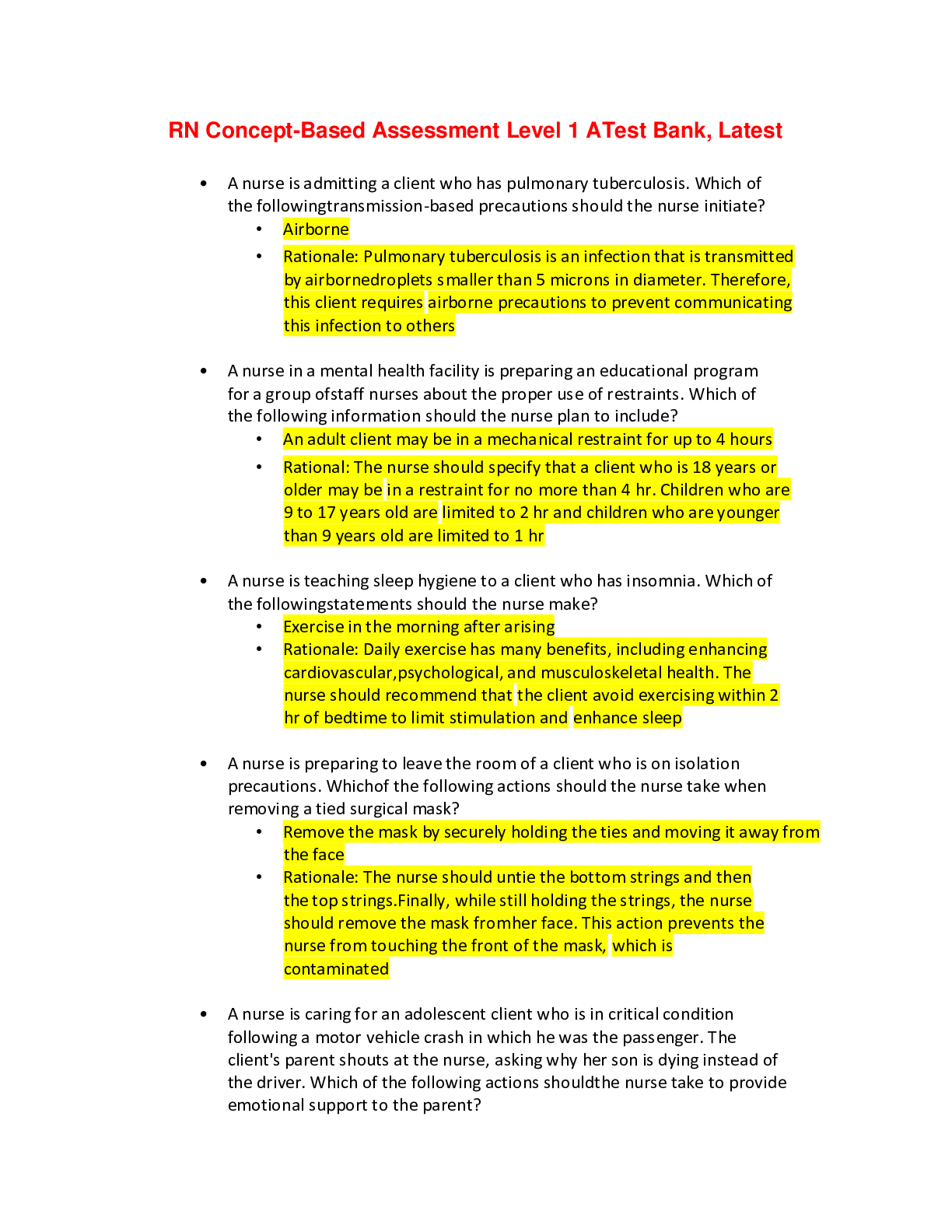
Reviews( 0 )
Document information
Connected school, study & course
About the document
Uploaded On
Feb 02, 2022
Number of pages
26
Written in
Additional information
This document has been written for:
Uploaded
Feb 02, 2022
Downloads
0
Views
124


.png)
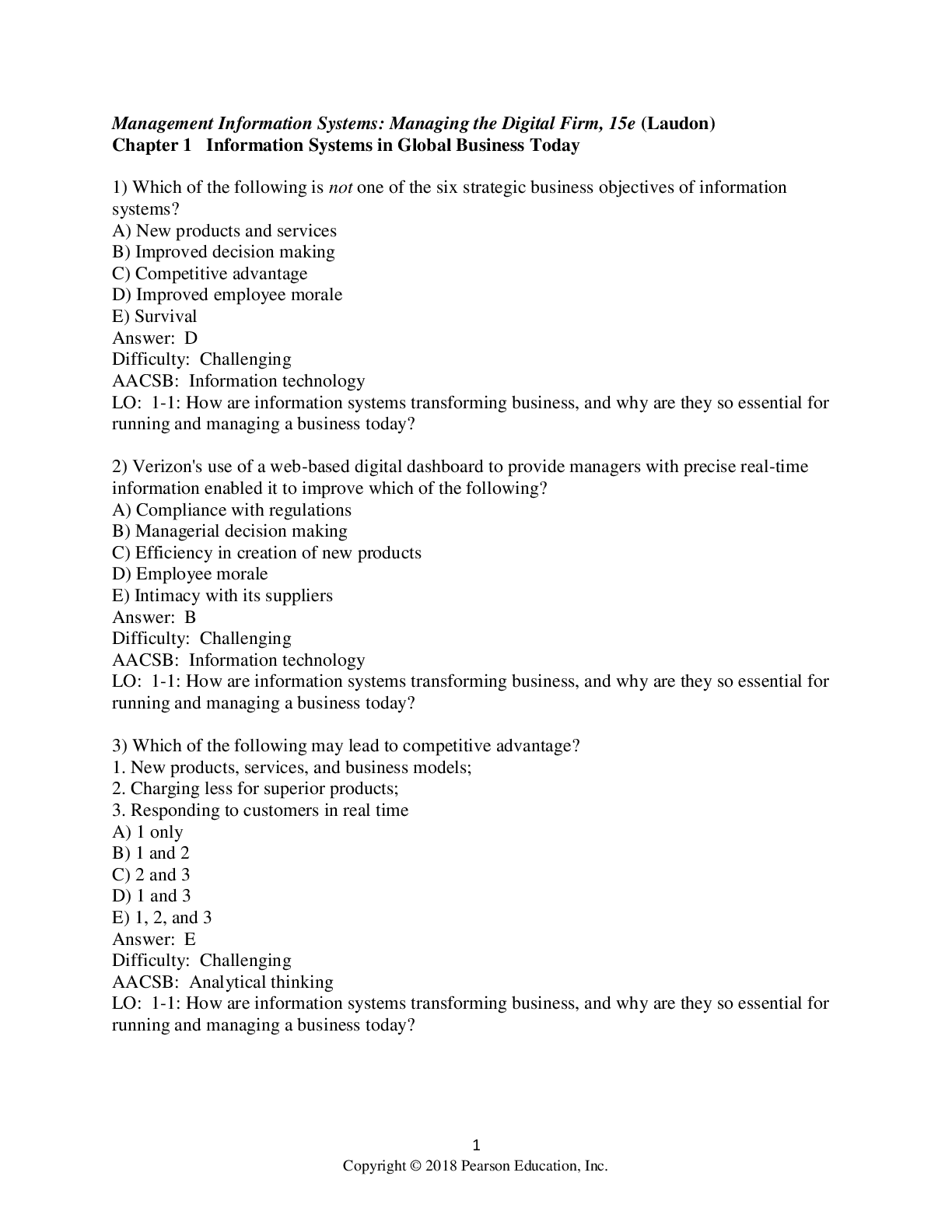
.png)
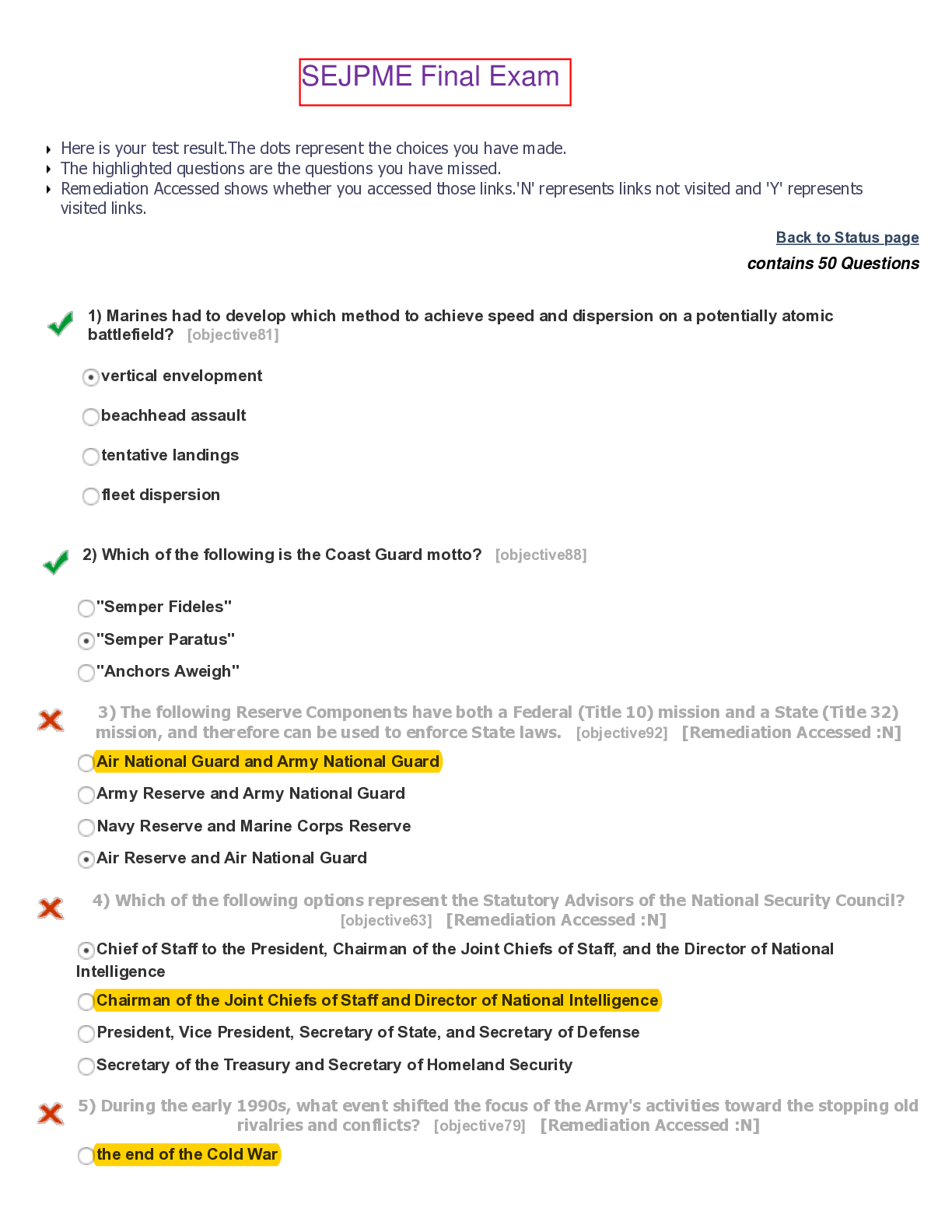

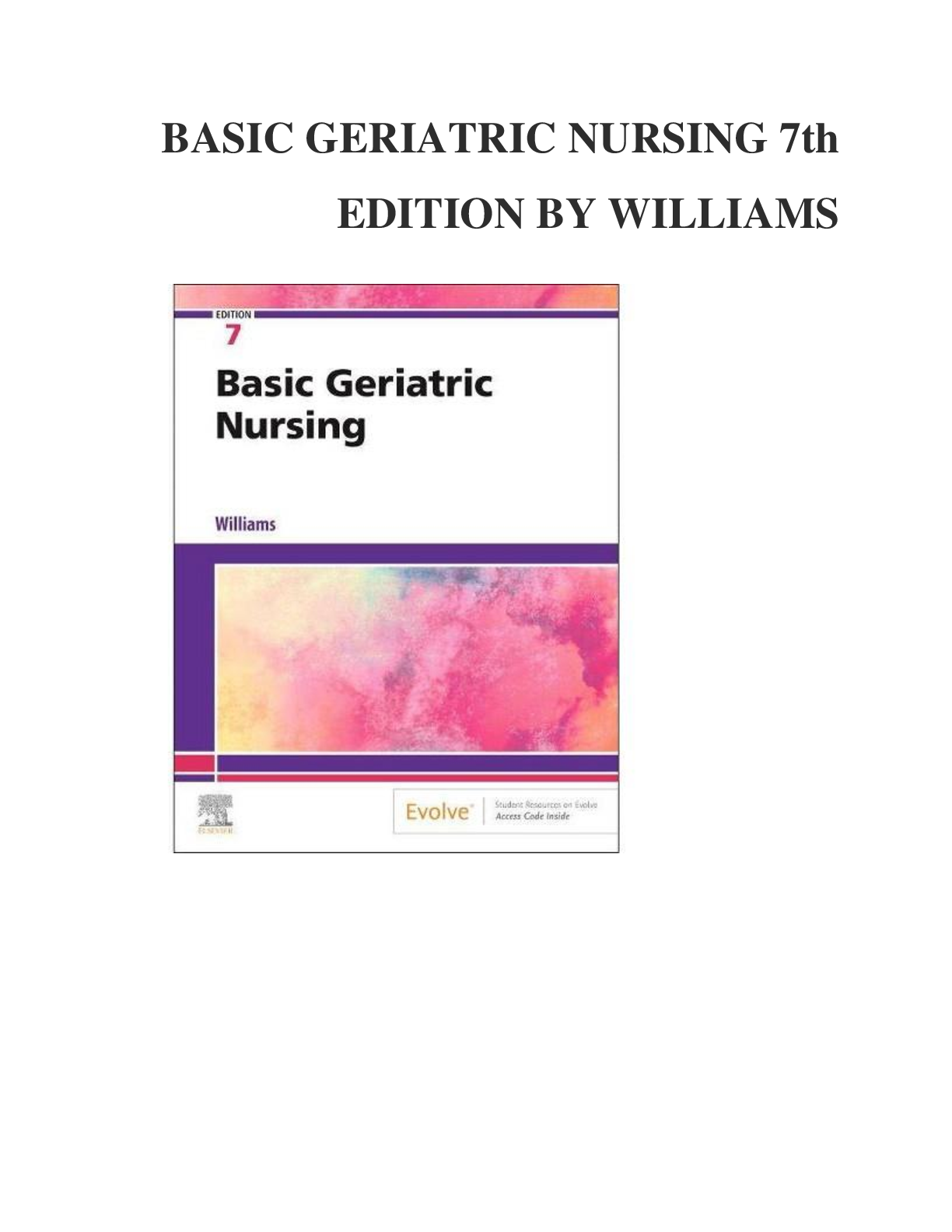
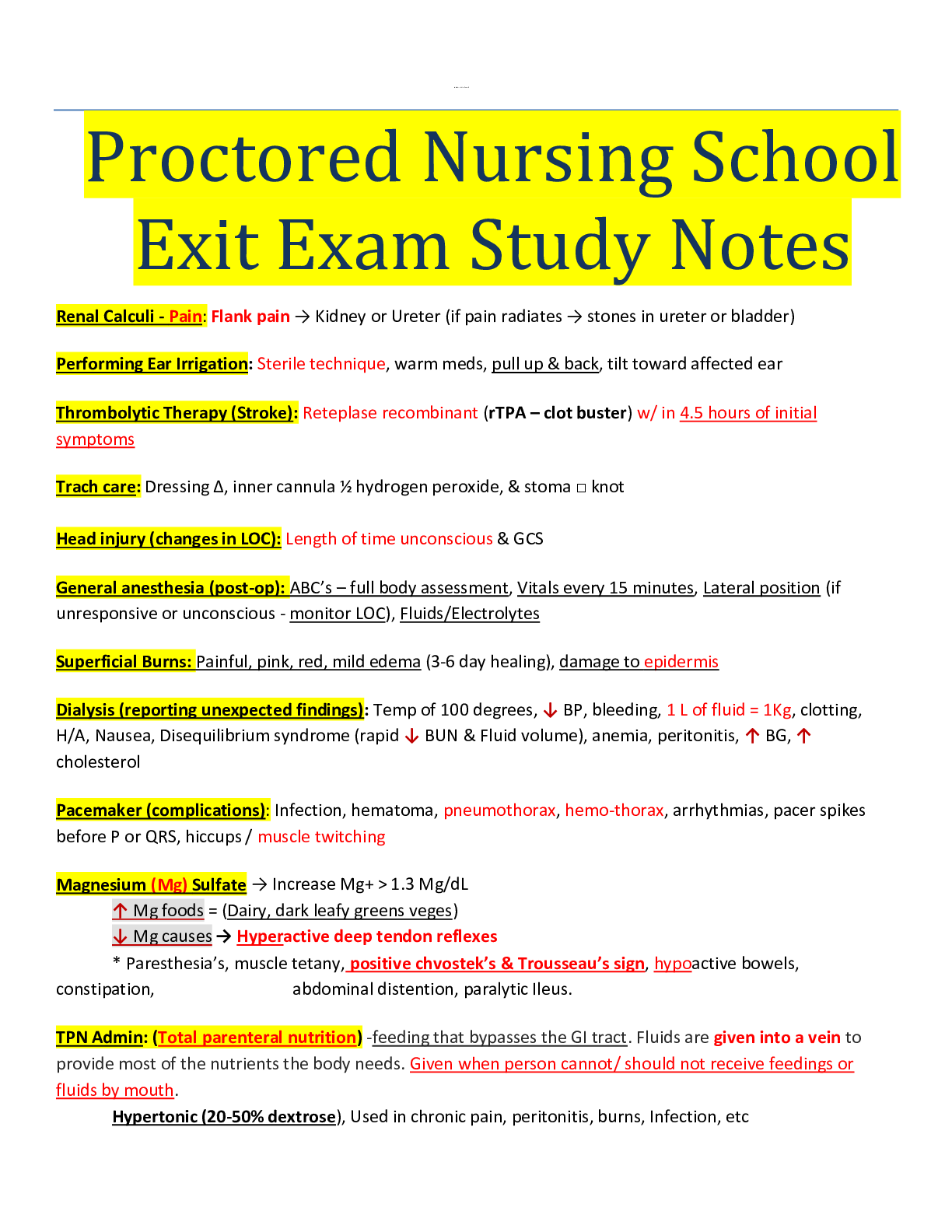
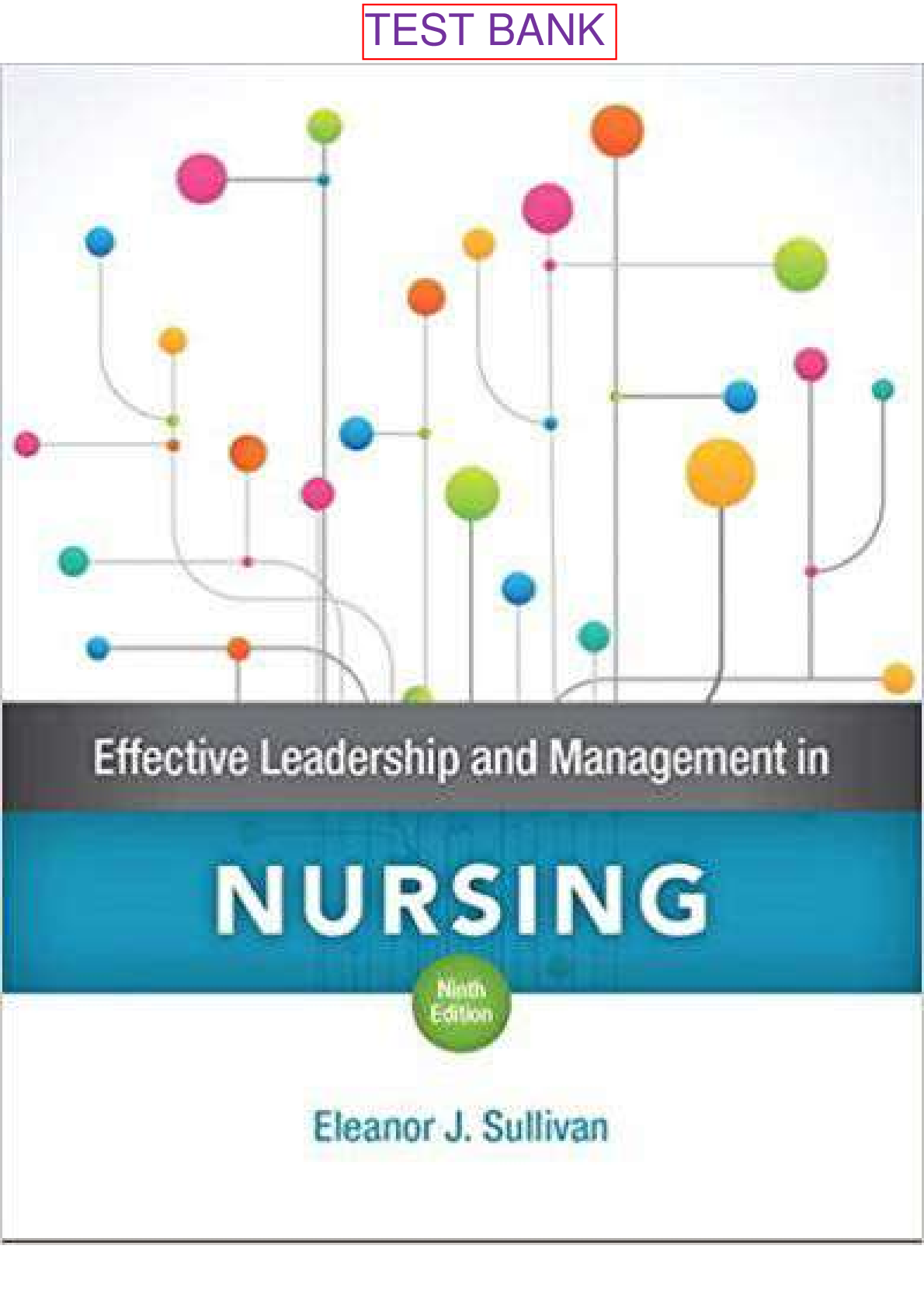
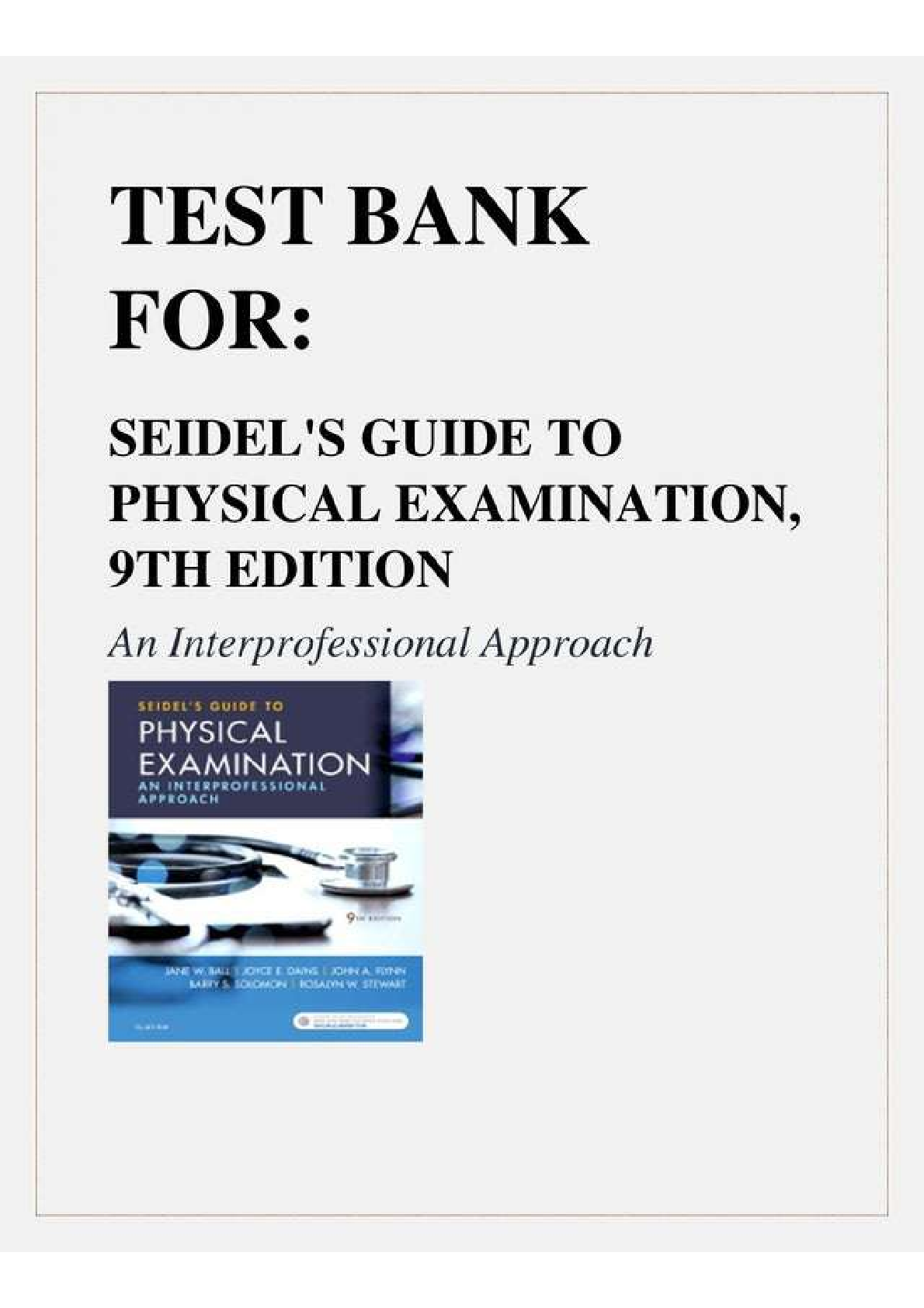
.png)
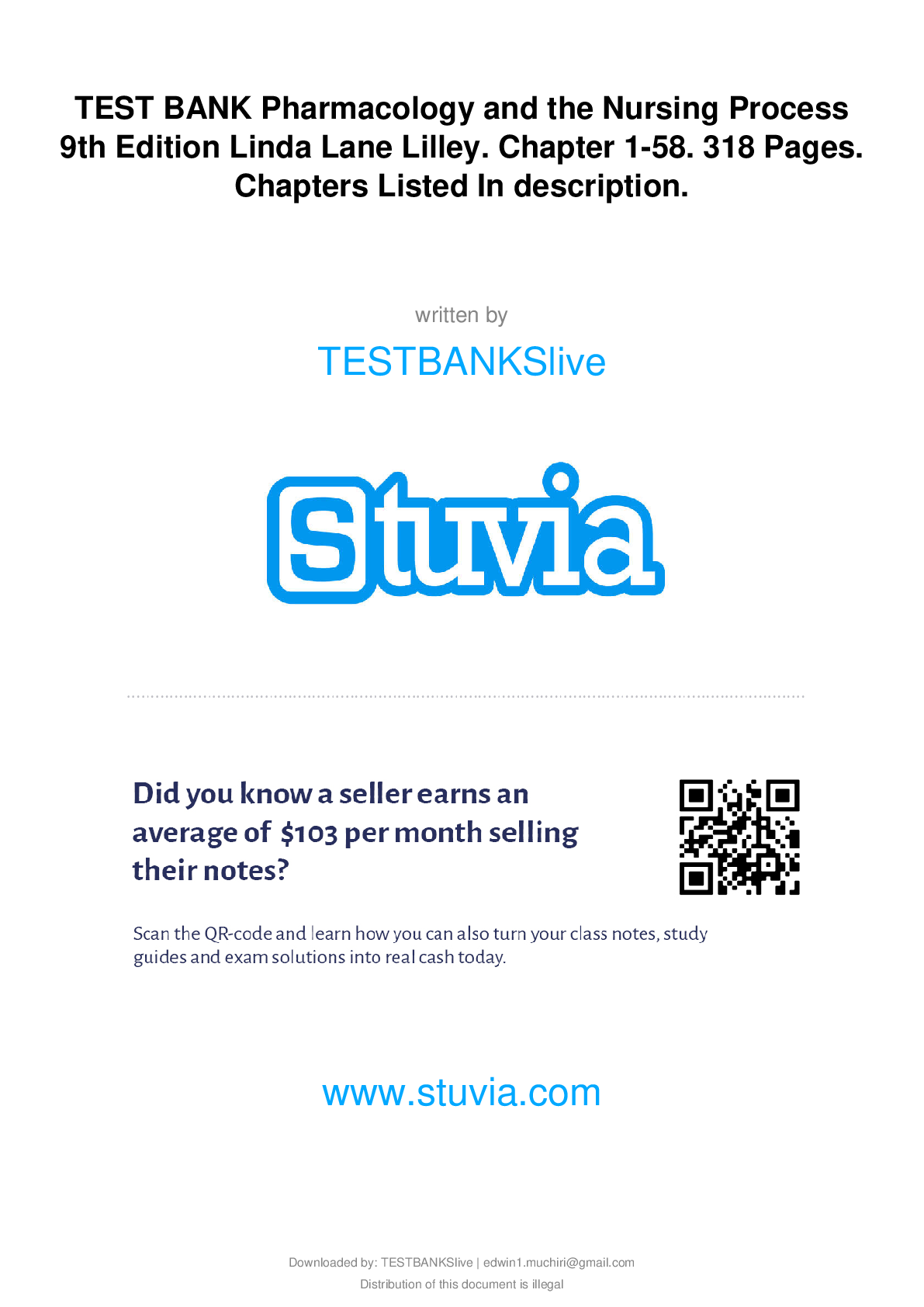
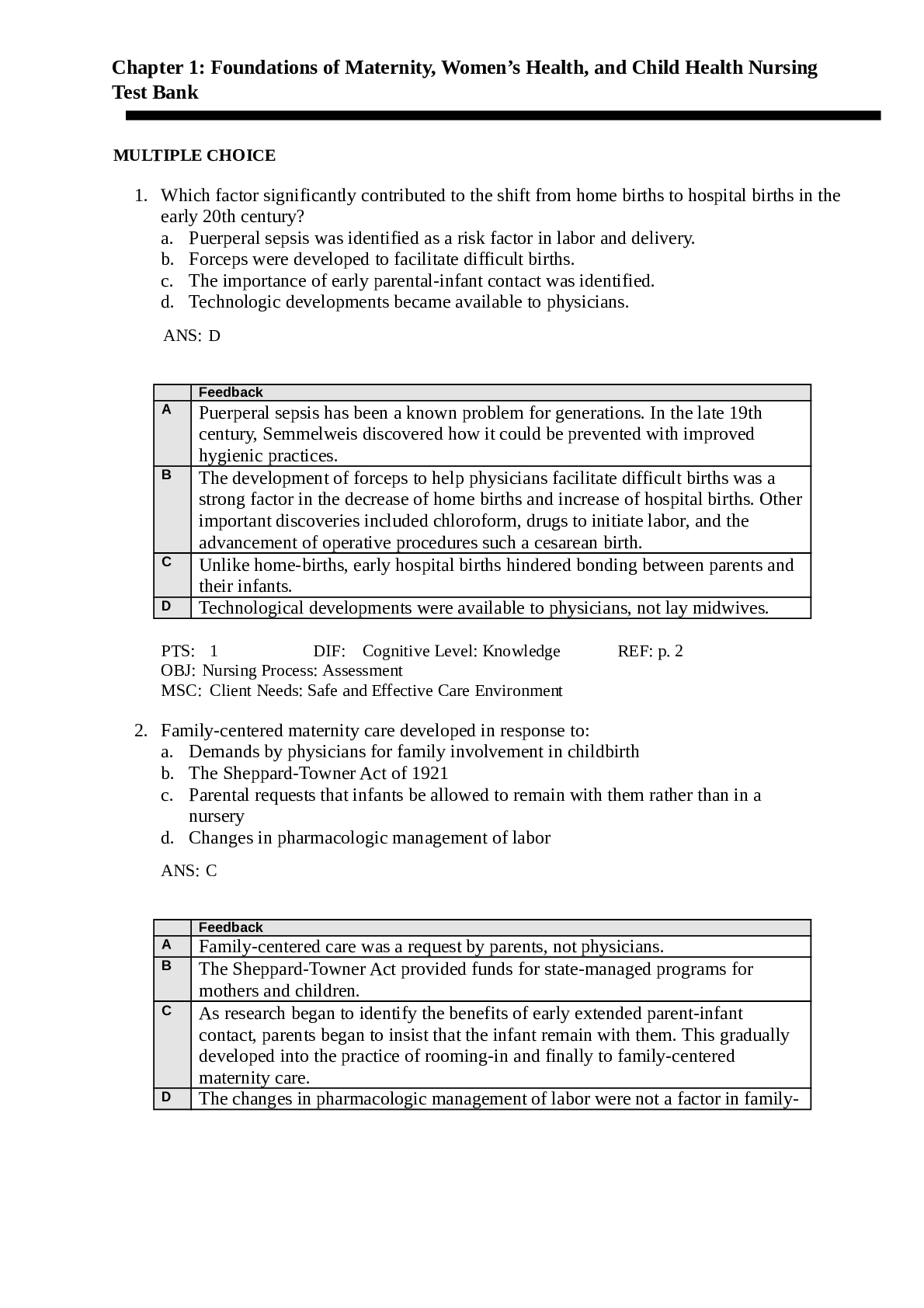
.png)
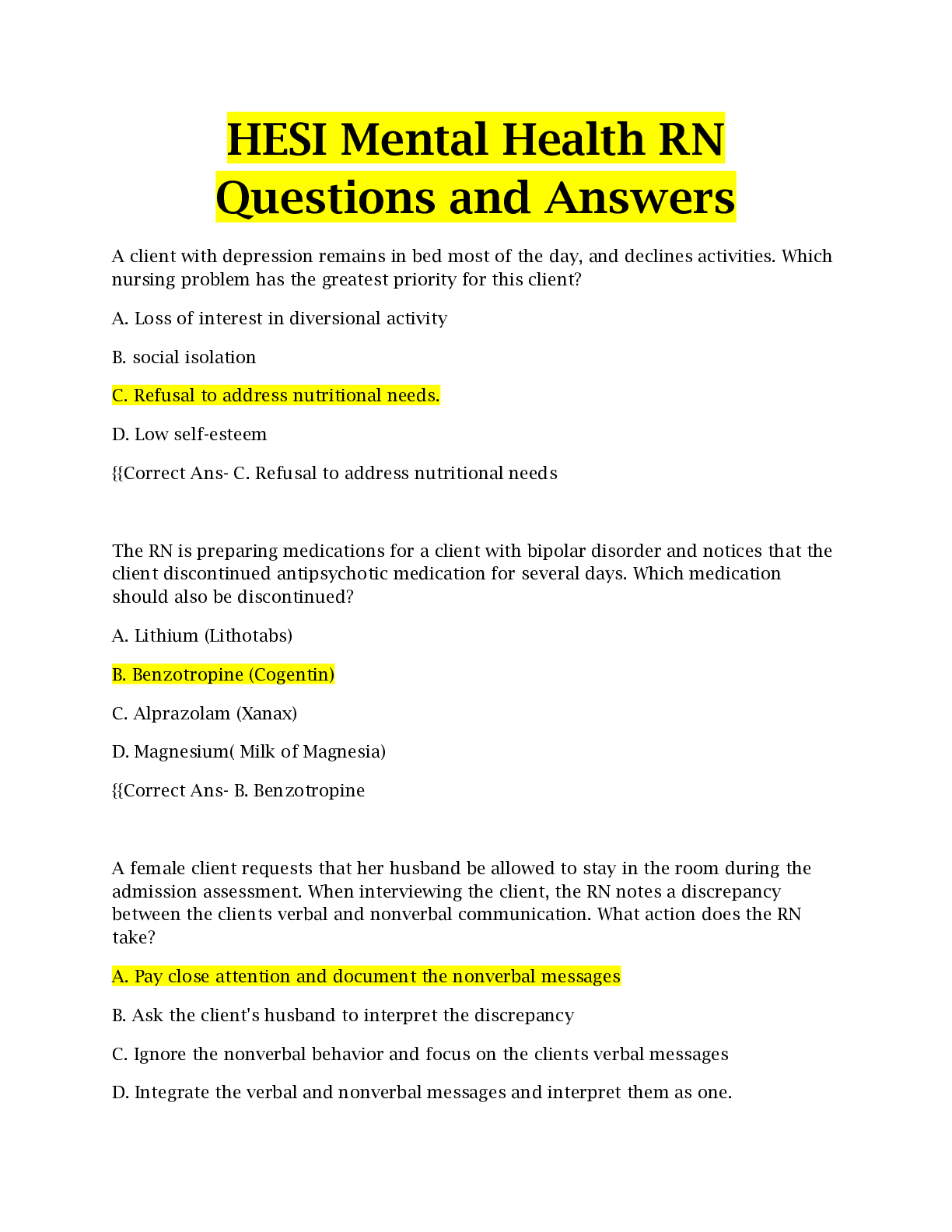
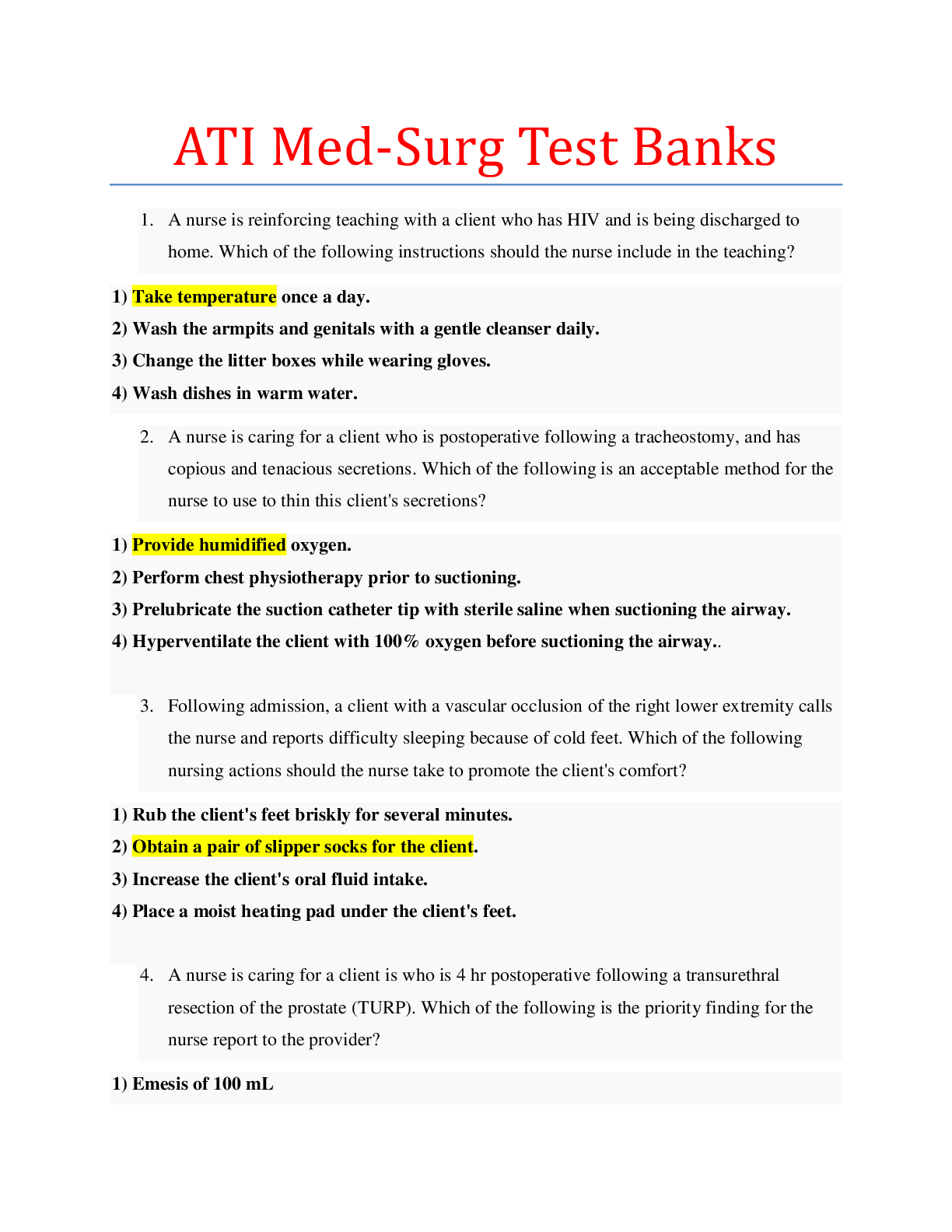
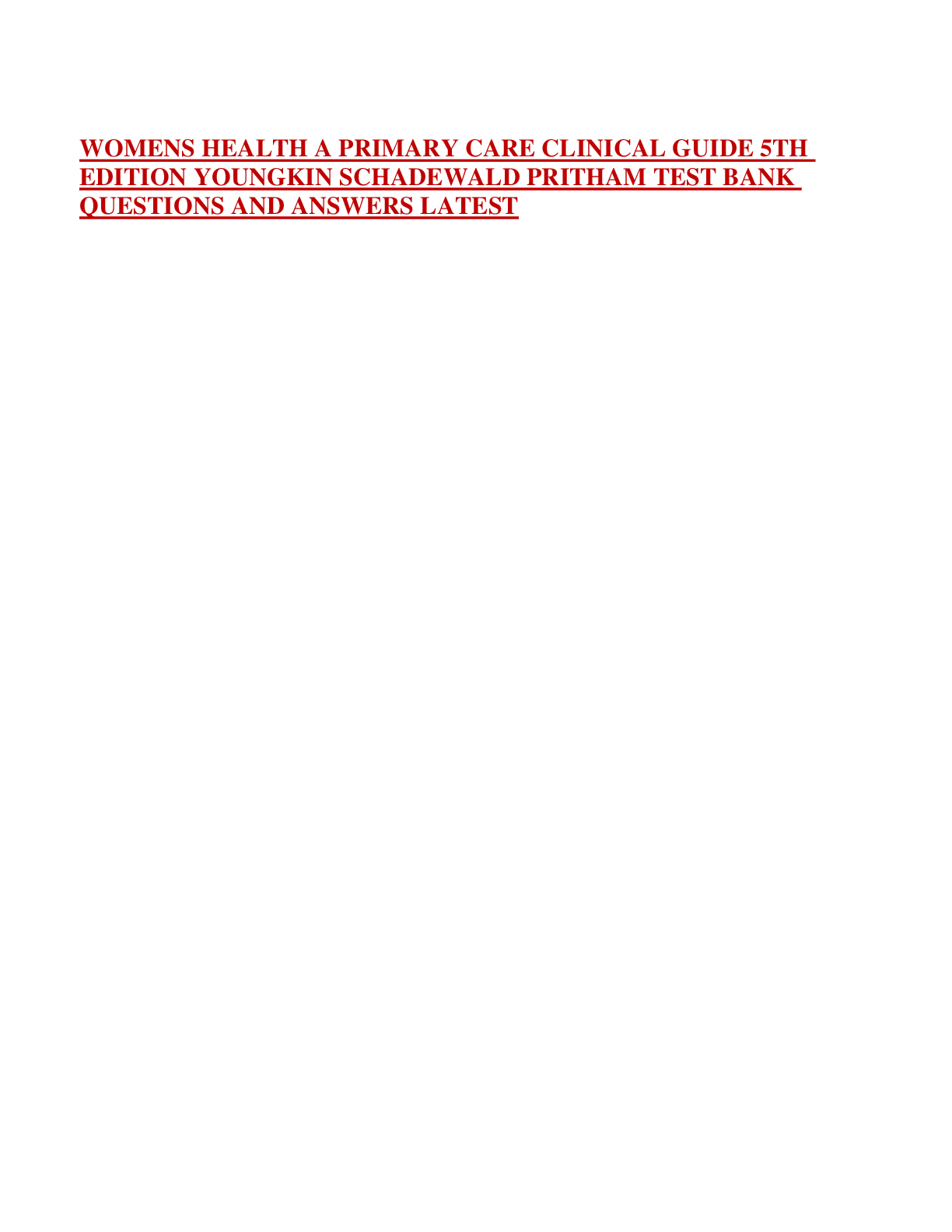
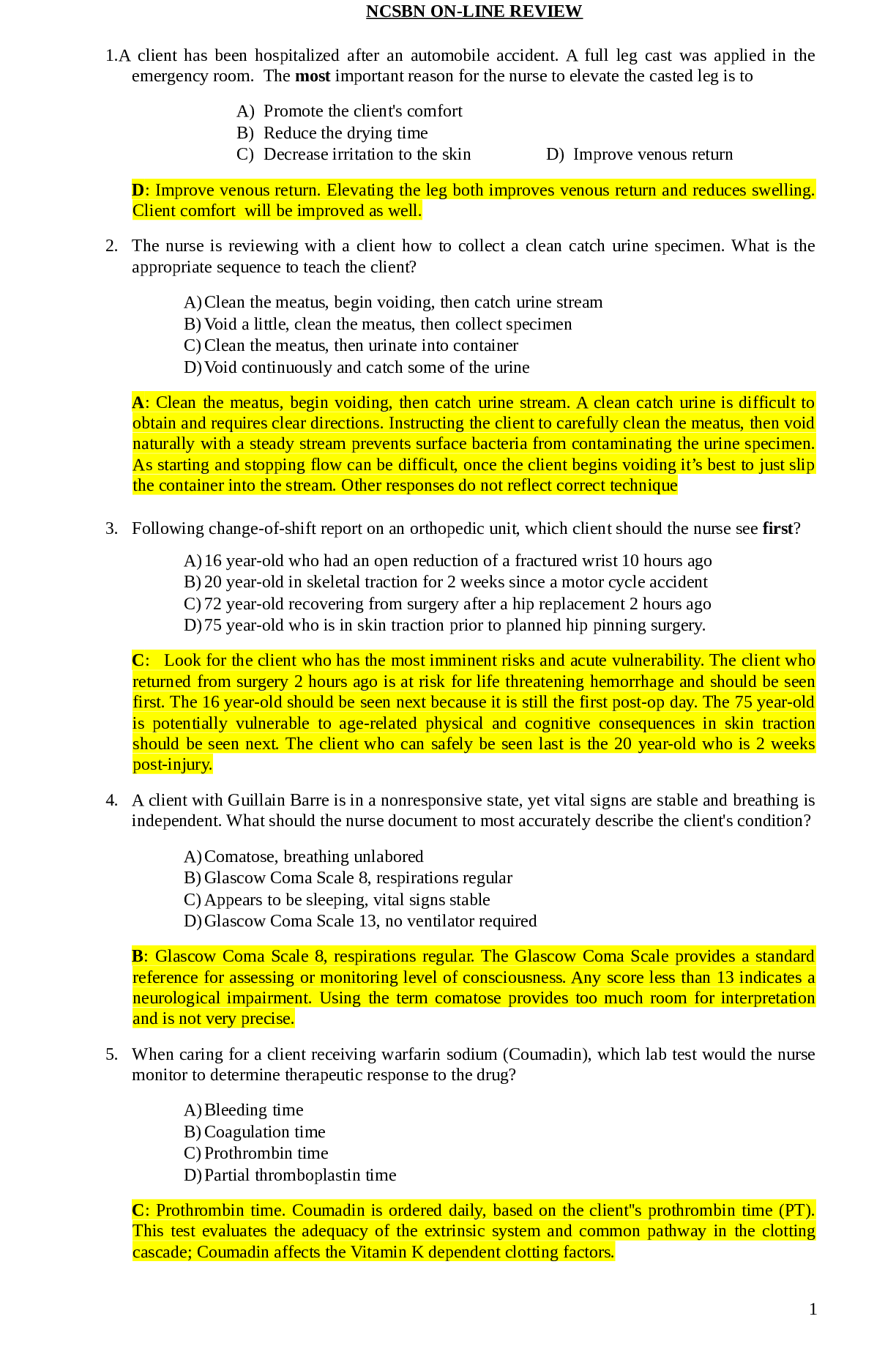

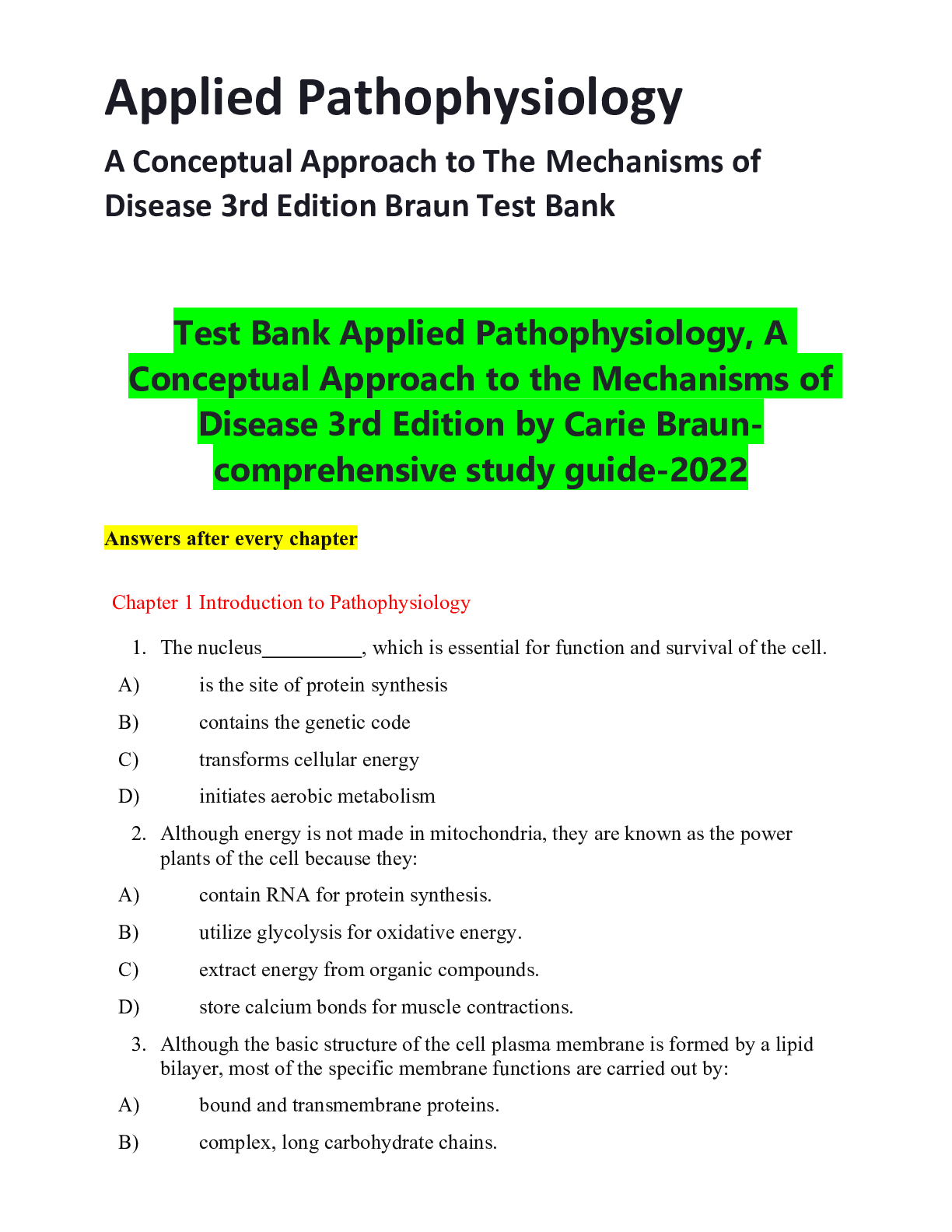
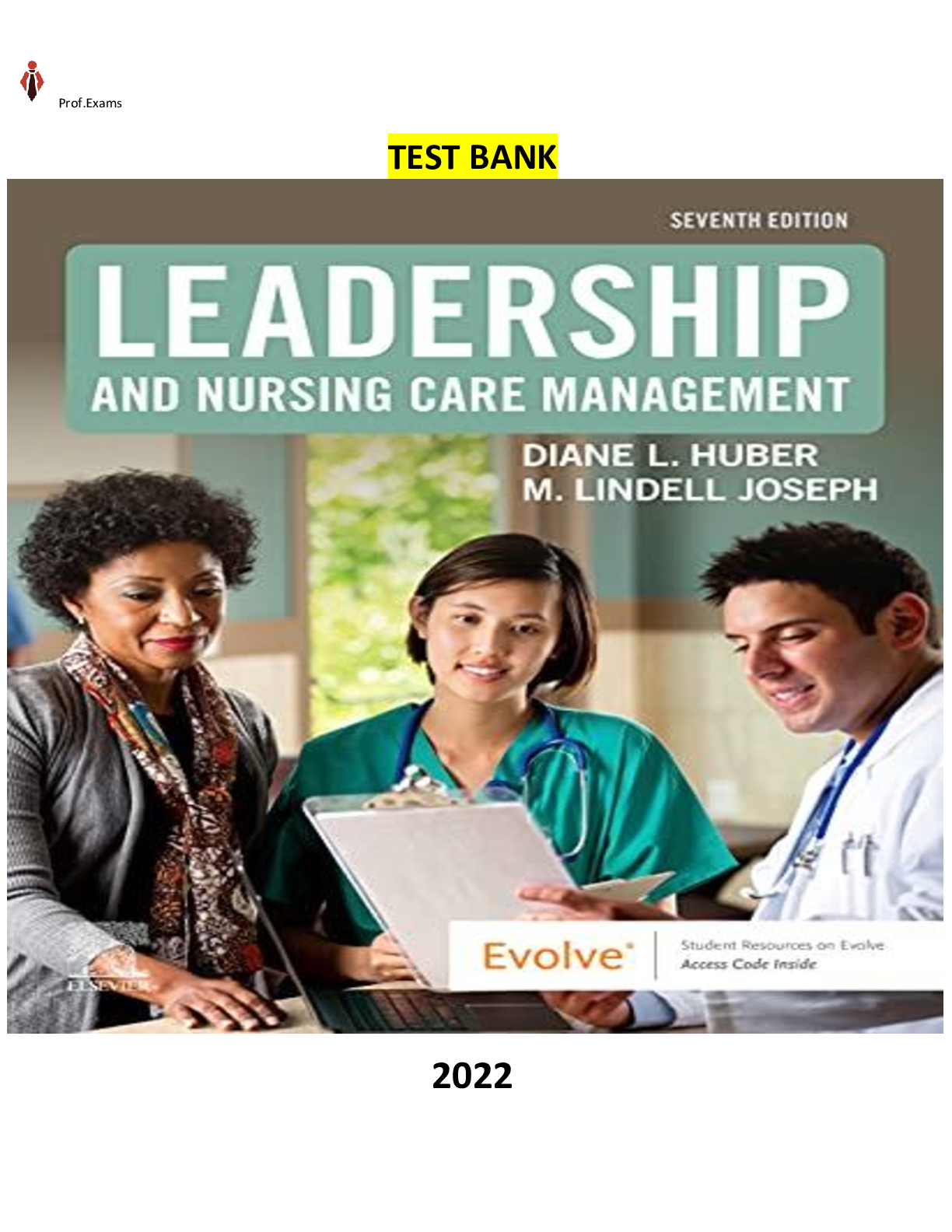
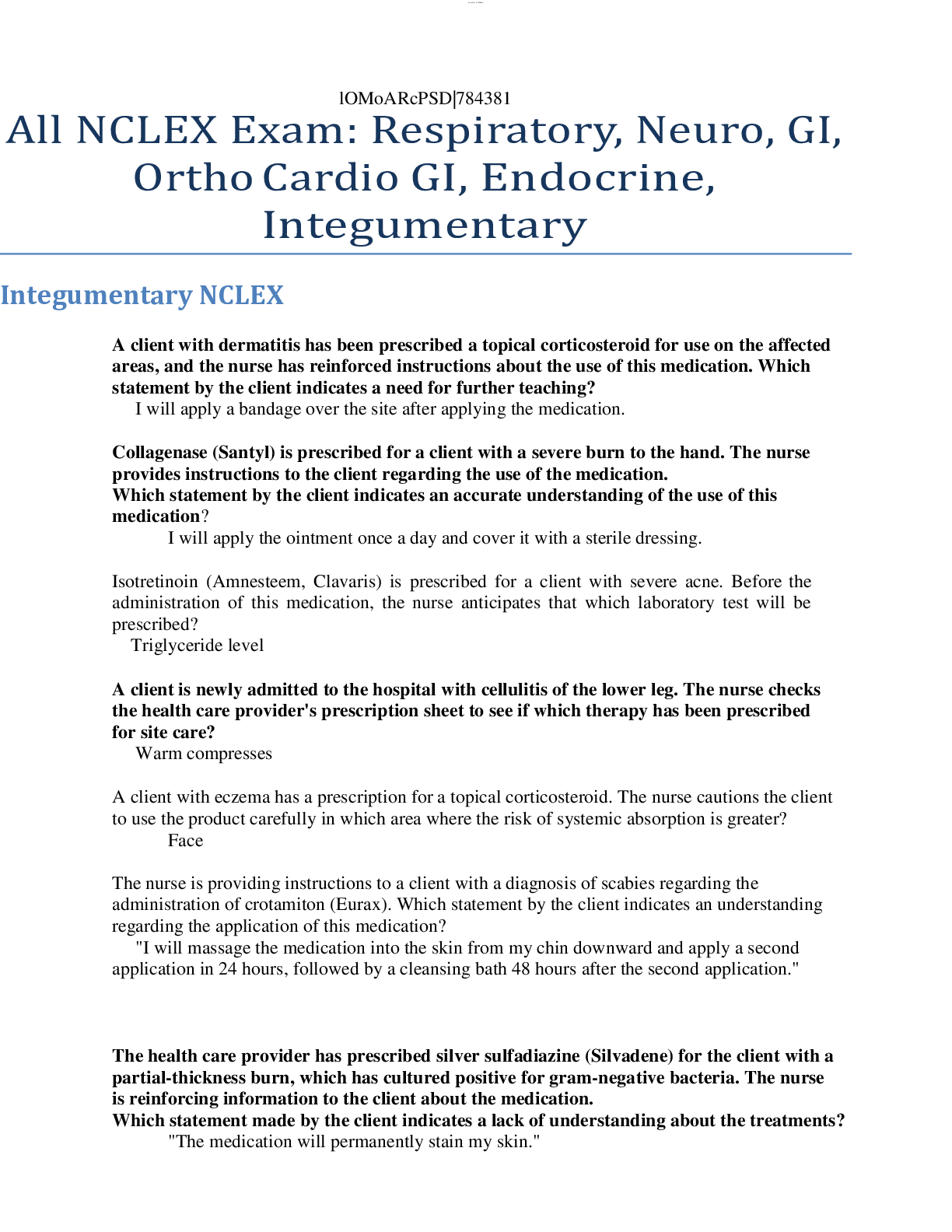
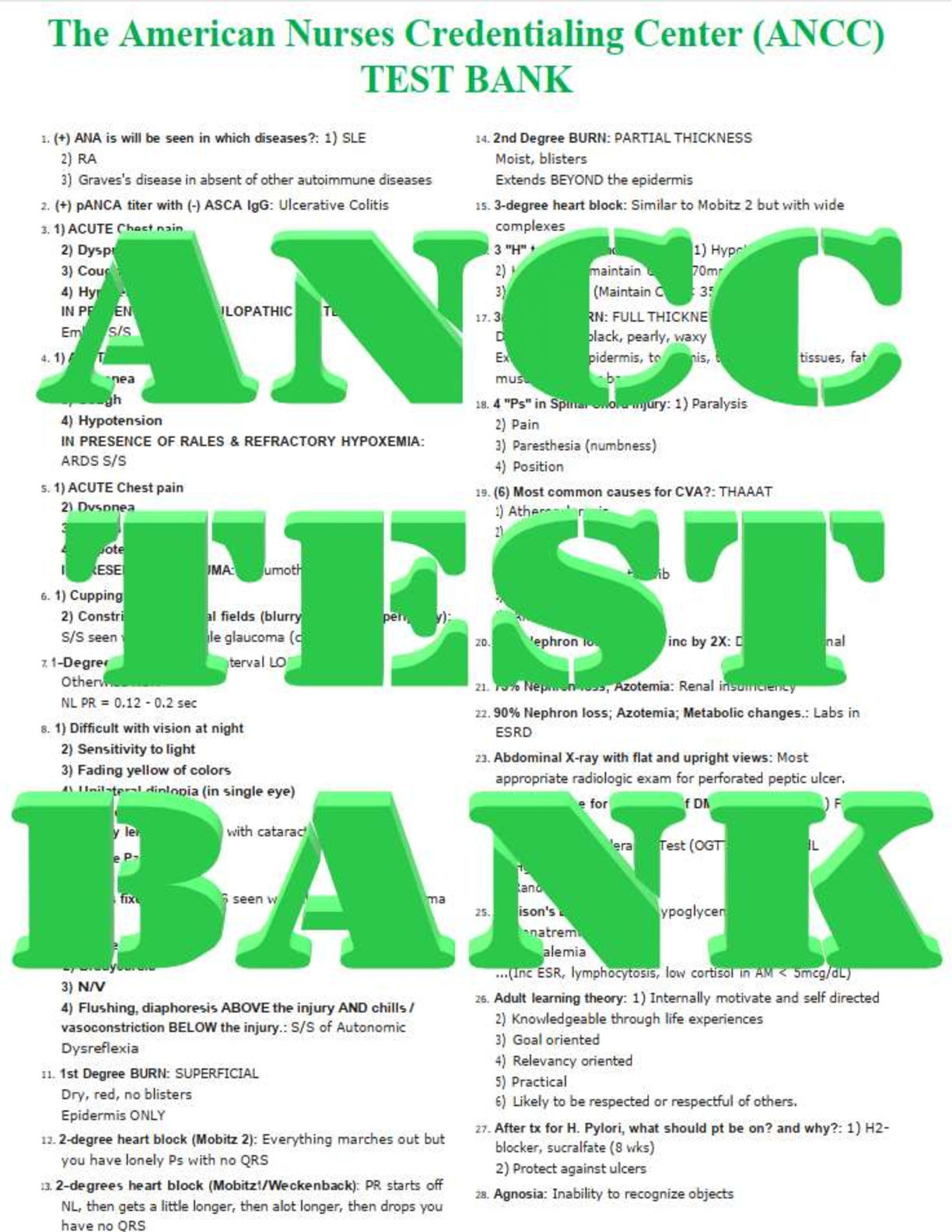
.png)
.png)
